|
Electronic Poster Session
Engineering |
Tuesday, 19 June 2018
Electronic PosterEngineering
4271 -4294 RF Coils & Arrays
4295 -4318 Dielectrics, Metamaterials & Field Control
4390 -4413 Simulations & Modeling
4414 -4437 MR Engineering Beyond RF Coils |
| |
RF Coils & Arrays
Electronic Poster
Engineering
Tuesday, 19 June 2018
| Exhibition Hall |
16:15 - 17:15 |
| |
|
Computer # |
|
4271.
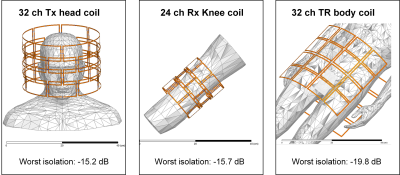 |
1 |
 Multi-row and Loopole-type Self-decoupled RF Coils Multi-row and Loopole-type Self-decoupled RF Coils
Xinqiang Yan, John Gore, William Grissom
Self-decoupled coils that do not require additional decoupling treatments provide increased freedom for RF array design. However, only a single-row array was demonstrated in the initial work and it is not clear whether this design can be applied to multi-row arrays. Furthermore, the initial self-decoupled coil was fed in a horizontal conductor and thus its B1 field was same as that of a conventional loop. If fed at a corner or in a vertical conductor, the self-decoupled coil may exhibit asymmetric currents and act as a “loopole” which can be used to improve transmit or receive performance. In this work, we proposed several solutions for multi-row arrays and also investigate loopole-type self-decoupled coils. We found that the self-decoupled coil design can be applied to multi-row arrays with a simple modification (fed at corner) or adding another decoupling method (such as overlapping). The self-decoupled method could also be used to improve transmit efficiency and SNR by optimizing the feed port’s positions.
|
|
4272.
 |
2 |
 A Split 8-channel 7T Knee Coil A Split 8-channel 7T Knee Coil
Xinqiang Yan, John Gore, William Grissom
Split coil designs are attractive to provide easy access and tight-fitting for patients. A common split coil uses plug connectors to join the two halves together. But this requires additional mechanical design to ensure a robust and reliable connection. In this work, we propose a novel split array coil for 7T knee imaging where the two halves are electrically isolated from each other and do not need any geometrical constraints such as overlapping. The array comprises mixed self-decoupled loop coils and conventional loop coils, which can be split between the self-decoupled coils because they are intrinsically decoupled. This design also allows their distance to be slightly adjusted for different subjects and adapt to more of the population, while fitting tightly around the anatomy for higher sensitivity.
|
|
4273.
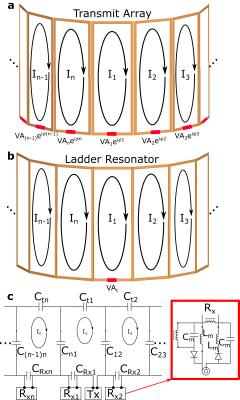 |
3 |
 Application of Asymmetric Mode Ladder Resonators for Improved Efficiency of Individual Elements in Transceive Arrays Application of Asymmetric Mode Ladder Resonators for Improved Efficiency of Individual Elements in Transceive Arrays
Adam Maunder, Fraser Robb, Madhwesha Rao, Jim Wild
Conventional vest coil designs typically have less homogeneous excitation and higher SAR than volume resonators. Here we introduce a hybrid of a ladder resonator and transceiver array to provide the individual benefits of both. A network theory approach is presented for the calculation of tuning values. Simulation and measurement of a two ladder element transmit array with three loop sections each is demonstrated. Additionally, the six individual loop sections are employed as separate receive coil elements. Improved transmit homogeneity and lower specific absorption ratio is observed in simulation against a comparable transmit vest coil array. The tuning and transmit field homogeneity is verified through measurement of imaging performance.
|
|
4274.
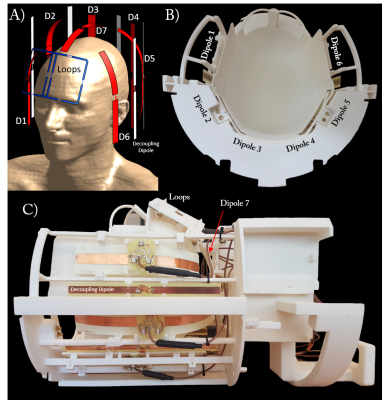 |
4 |
 8-channel whole-brain center-fed dipoles with quadrature frontal loops coil array 8-channel whole-brain center-fed dipoles with quadrature frontal loops coil array
Jérémie Clément, Sandra Da Costa, Rolf Gruetter, Özlem Ipek
To achieve highly efficient whole-brain coverage, including cerebral cortex and cerebellum, a single-row 8-channel RF coil array, built with center-fed dipoles, was investigated. B1+ maps and anatomical images were acquired on the human brain for RF phases optimized over the whole-brain and high transmit field performances were shown in both cerebral cortex and cerebellum with good homogeneity. Functional MRI data was acquired on auditory cortices and demonstrated higher robustness compared to a commercial volume coil.
|
|
4275.
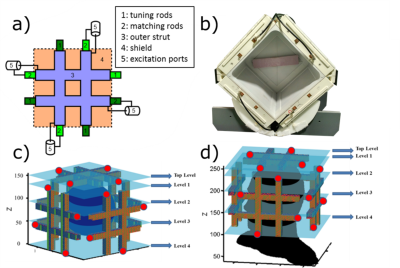 |
5 |
 Experimental and numerical evaluations of simultaneously excitable Eigenmodes in a 20-channel transmit RF array for 7 Tesla human MRI Experimental and numerical evaluations of simultaneously excitable Eigenmodes in a 20-channel transmit RF array for 7 Tesla human MRI
Tales Santini, Yujuan Zhao, Sossena Wood, Junghwan Kim, Nadim Farhat, Narayanan Krishnamurthy, Tiejun Zhao, Tamer Ibrahim
The Eigenmodes of a 20-channel Tic-Tac-Toe RF array are presented and analyzed. The Eigenmodes were calculated for each excitation level in Z (static magnetic field) direction, resulting in 4 modes per level and 20 in total. FDTD simulations and in-vivo experiments were performed. Quadrature mode is the most efficient, and generally excites the center of the brain; Anti-quadrature mode excites the head periphery; and the Zero-phase mode excites the cerebellum. Up to 5 modes can be excited simultaneously which can potentially result in a homogenous B1+ pattern and low levels of Average/peak SAR.
|
|
4276.
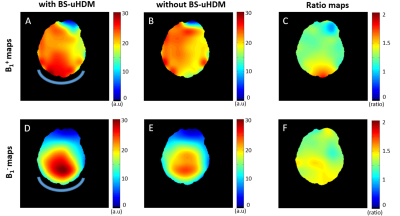 |
6 |
SNR Improvement of In Vivo 31P MRSI in Human Brain using Head-Shape Ultrahigh Dielectric Constant Material at 7T
Video Permission Withheld
Byeong-Yeul Lee, Xiao-Hong Zhu, Sebastian Rupprecht, Maryam Sarkarat, Michael Lanagan, Qing Yang, Wei Chen
Increased RF power (thus, higher SAR) and inadequate detection sensitivity (or SNR) even at high/ultrahigh field are the major challenges for X-nuclei MRS imaging (MRSI) for human applications. In this work, we demonstrate that using the ultrahigh dielectric constant material (uHDM) conformed to the human head incorporated into the RF head volume coil, improved detection sensitivity and reduced demand of RF transmit power were achieved across an entire object for testing phantom and human brain 31P MRSI at 7T. Therefore, incorporating optimized geometry of uHDM with RF coil can significantly boost SNR and reduce SAR in X-nuclei MRS applications, ultimately, improve spatiotemporal resolution.
|
|
4277.
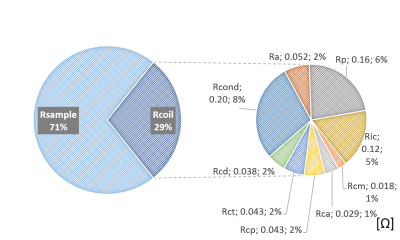 |
7 |
 High-accuracy SNR calculation for multi-channel receiver coils with electromagnetic simulation considering coil-component losses High-accuracy SNR calculation for multi-channel receiver coils with electromagnetic simulation considering coil-component losses
Kohjiro Iwasawa, Yosuke Otake, Hisaaki Ochi, Hideta Habara, Masayoshi Dohata, Yoshihisa Soutome
Electromagnetic simulation is a powerful tool to evaluate optimal radio frequency (RF) coil design without costly prototypes. However, RF receiver coils have accessory circuits, such as decoupler circuits, that make it difficult to reflect accurate coil loss. This leads to calculation error which can be non-negligible even in high static magnetic fields, especially for small loop coils. We measured the coil-component losses and took them into account for the simulation to calculate the signal-to-noise ratio (SNR). The calculated SNR had less than 5% error when compared to SNR measured with a 1.5-T MRI scanner for 10-channel receiver-array coils, confirming high accuracy of multi-channel SNR simulation.
|
|
4278.
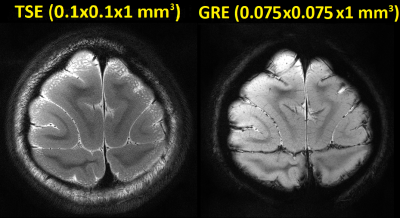 |
8 |
A 16-channel Dense Array for Macaque Cortices Imaging at 7T
Did Not Present
Xiaotong Zhang, Yang Gao, Meizhen Qian, Yi Sun, Anna Roe
To improve the SNR and time efficiency of monkey brain imaging, we designed a multi-channel dense receive array for use at 7T. It can be flexibly mounted over the monkey’s head and can be used for studies in both awake and anesthetized conditions. The aim of the current design focuses on visualizing sub-millimeter tissue structure and probing neuronal activities in cortices of macaques, and as demonstrated in the experiment results, good SNR and tSNR are attained in cortical layers and up to ~1cm depth beneath the skull. The area of B1 sensitivity is large enough to encompass any area of the visual cortex.
|
|
4279.
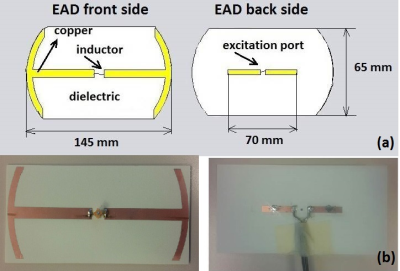 |
9 |
 Evaluation of Egyptian axe dipole antenna as an array element for head imaging at 7T MRI Evaluation of Egyptian axe dipole antenna as an array element for head imaging at 7T MRI
Irena Zivkovic, Thomas O'Reilly, Wyger Brink, Andrew Webb
In this abstract we propose a new antenna design as a transmit array element for proton head imaging at 7T that combines a small feeding dipole that is capacitively coupled, as a so-called ‘indirect’ or ‘passive’ feed, to an ‘Egyptian’ axe dipole. B1+ and SAR efficiency of the proposed antenna have been compared numerically with a conventional dipole antenna of the same length. A head array consisting of eight antenna elements has been constructed and tested. This array element offers a large reduction in SAR compared to equally sized linear dipoles while maintaining their B1+ profile as well as reducing the impact of antenna loading on the resonance frequency.
|
|
4280.
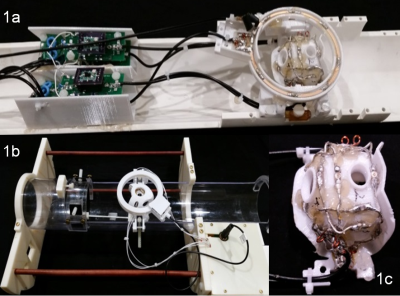 |
10 |
 Marmoset coil arrays for functional imaging of awake monkeys at 9.4T and 3T Marmoset coil arrays for functional imaging of awake monkeys at 9.4T and 3T
Azma Mareyam, Jitendra Sharma, Mitul Desai, Christin Sander, Eric Frederick, Benjamin Bartelle, Atsushi Takahashi, Lawrence Wald
High-field functional MRI of non-human primates provides elevated BOLD contrast in a well-established neuroscience model but requires an optimized coil design to boost the SNR, facilitate image acceleration while maintaining mechanical and electrical stability during the awake primate experiment. In this work we have constructed and tested 4-channel 9.4T and a 5-channel 3T receive-only array optimized for high-resolution whole-brain imaging of the anesthetized and awake marmosets.
|
|
4281.
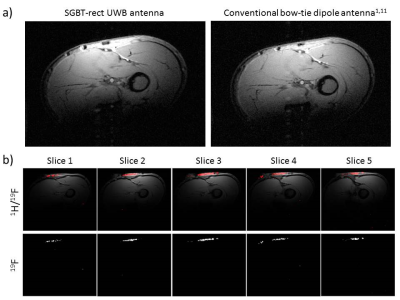 |
11 |
 One for all: Ultra-wideband (279-500MHz) self-grounded bow-tie antenna for ultrahigh-field and thermal MR One for all: Ultra-wideband (279-500MHz) self-grounded bow-tie antenna for ultrahigh-field and thermal MR
Lukas Winter, Hana Trefná, Yiyi Ji, Till Huelnhagen, Thoralf Niendorf
A compact self-grounded ultra-wideband bow-tie antenna is presented that operates in a frequency range from 279 MHz (19F at 7.0 T) up to 500 MHz (1H at 11.7 T). The antenna is smaller and lighter than previous designs making it an excellent candidate for high density multi-channel transmit/receive arrays. It can be driven directly at 50Ω eliminating the need for a tuning/matching circuit and associated component losses and costs. The ultra-wideband antenna was tested successfully in-vivo at 7.0 T for 19F and 1H imaging. Its design supports high average power applications such as targeted RF heating or thermal MR.
|
|
4282.
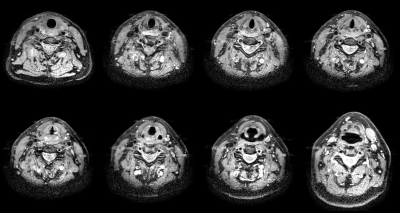 |
12 |
 Development of a dedicated laryngeal surface coil for improved high resolution imaging in laryngeal cancer Development of a dedicated laryngeal surface coil for improved high resolution imaging in laryngeal cancer
Thomas Ruytenberg, Berit Verbist, Jordi Vonk-Van Oosten, Paul de Bruin, Eleftheria Asteinidou, Elisabeth Sjogren, Andrew Webb
A dedicated 4-channel larynx coil at 3T has been developed, allowing for high-resolution (1 mm isotropic) imaging of the larynx. The coil is flexible and can therefore be used on a radiotherapy mask to allow in-mask scanning of the larynx for radiotherapy planning purposes. Breathing and swallowing artefacts were eliminated using respiratory triggering and artefacts arising from pulsatile flow were suppressed using a saturation pulse. The improved image quality and resolution helps in assessing whether transoral surgical approaches on laryngeal tumors are possible.
|
|
4283.
 |
13 |
 Improved transmit efficiency with Slotted Microstrip Transmission Line RF Coil Element for Ultra-high magnetic field MR Imaging Improved transmit efficiency with Slotted Microstrip Transmission Line RF Coil Element for Ultra-high magnetic field MR Imaging
Vijayaraghavan Panda, Siva Sai Krishna Puranam, Lance Delabarre, Gregor Adriany, Anand Gopinath
Slots are introduced to the standard microstrip transmission line RF coil element, to enhance the current density and obtain better improved transmit efficiency. A prototype of such a slotted microstrip element is compared with the standard microstrip element at 297.25 MHz for 7T MR scanner to show the feasibility of the design at higher magnetic fields. A 60% improvement in the transmit efficiency and increased penetration of field into the phantom are observed experimentally. The B1+ field distribution in both transverse and sagittal plane are shown for the comparison.
|
|
4284.
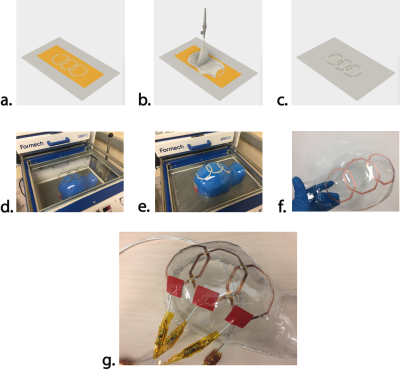 |
14 |
 Perfectly Conformal Coils: A Novel Method for Patterning Coils on Complex 3D Surfaces Perfectly Conformal Coils: A Novel Method for Patterning Coils on Complex 3D Surfaces
Karthik Gopalan, Ana Arias, Michael Lustig
We describe a novel technique for fabricating coils on complex three dimensional surfaces. Conductors are printed on a planar sheet then vacuum formed to create arrays that perfectly conform to the body. We envision a process where a custom coil can be built to completion at the push of a button. Through a combination of 3D scanning, RF modeling, and mechanical simulation, coils could be rapidly manufactured for any body part. Here, we demonstrate the first steps toward our goal by building a 3 channel posterior head coil and scanning in vivo at 3T.
|
|
4285.
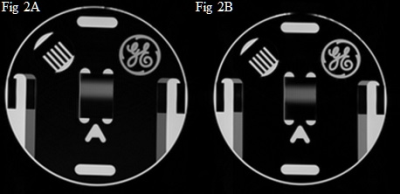 |
15 |
 A 3He/1H Switched Frequency High-Pass Birdcage Coil for Hyperpolarized 3He Imaging in Neonates at 1.5 T A 3He/1H Switched Frequency High-Pass Birdcage Coil for Hyperpolarized 3He Imaging in Neonates at 1.5 T
Ronald Pratt, Randy Giaquinto, Christopher Ireland, Barret Daniels, Wolfgang Loew, Nara Higano, Robert Thomen, Jason Woods, Charles Dumoulin
We report details on the fabrication and performance of a transmit/receive 3He/1H switched frequency 16 rung high-pass birdcage coil for neonatal imaging at 1.5 Tesla. The coil enables collection of 3He images of neonatal lungs inflated with hyperpolarized 3He gas and ultra-short echo time (UTE) 1H images. Rotation of a shaft in the coil housing shifts the coil between 3He and 1H operating modes. 3He and UTE 1H images of explanted lungs inflated with hyperpolarized 3He gas collected using the coil demonstrate the excellent image quality achieved with the coil.
|
|
4286.
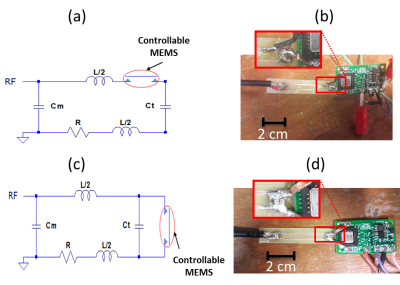 |
16 |
 Comparison of single-loop endoluminal receiver coils based on serial or parallel active decoupling circuits using controllable MEMS switches Comparison of single-loop endoluminal receiver coils based on serial or parallel active decoupling circuits using controllable MEMS switches
HAMZA RAKI, ISABELLE SANIOUR, FRASER ROBB, KEVIN TSE VE KOON, HENRI SOUCHAY, SIMON A. LAMBERT, OLIVIER BEUF
Two prototypes of single-loop endoluminal receiver coils integrating serial and parallel active decoupling circuits using controllable MEMS switches were built and compared to a reference coil with PIN-diode circuit. Parallel MEMS coil had a significantly higher quality factor compared to the serial MEMS coil and the reference coil. The switching delays of both MEMS coils were about few microseconds (< 8µs). The characterization on 3.0T MRI system showed comparable signal intensity distribution for the different coil configurations.
|
|
4287.
 |
17 |
 Wavelength independent ?/40 Composite Right/Left-Handed Transmission Line Coil Wavelength independent ?/40 Composite Right/Left-Handed Transmission Line Coil
Dongyean Koh, Jörg Felder, Chang-Hoon Choi, N. Jon Shah
A Dual Series (DS) Composite Right/Left Handed (CRLH) Microstrip Transmission Line (MTL) coil for MRI was designed and verified in a commercial 3T Scanner. According to metamaterial theory, we demonstrate the existence of the right-handed leaky mode to be in the UHF region. For design proposes we propose an equivalent circuit parameter extraction method and demonstrate that the phase velocity of the DS-CRLH MTL coil’s guided mode is located in a fast wave region.
|
|
4288.
 |
18 |
 A receive-only, double-tune coil using preamplifier decoupling A receive-only, double-tune coil using preamplifier decoupling
YongHyun Ha, Chang-Hoon Choi, Jörg Felder, N. Jon Shah
In this work we describe two methods for the double-tuned receive only coil design using preamplifier decoupling. Both the LC trap and the lattice balun can be integrated into the receive line to isolate signals resonant at two different frequencies. It was found that the method using LC traps was more effective when the coils were tuned at a higher frequency (normally proton), while the lattice balun method provided higher blocking impedance for the X-nuclei coil.
|
|
4289.
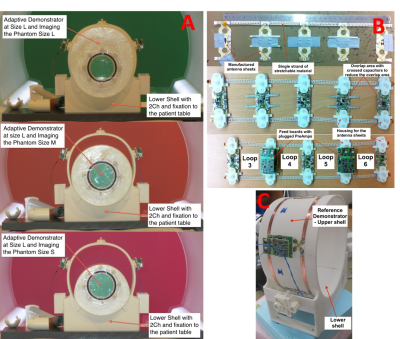 |
19 |
Anatomically adaptive coils for MR Imaging – A 6-channel Demonstrator Array study at 1.5 Tesla
Video Permission Withheld
Bernhard Gruber, Stephan Zink
Many of today’s MR coils are still somehow rigid and inflexible in their size. Even highly flexible arrays basically maintain only one specific body-part in a defined range. Anatomically adaptive coils potentially provide the necessary freedom to have a one-size-fits-all design for MRI in clinic. This would lower costs, improve the signal-to-noise ratio (SNR) and increase the patient comfort. To evaluate the potential SNR improvement of adaptive arrays, maintaining an optimal filling factor, a 6-channel Demonstrator array setup, comprised of stretchable loop elements at 1.5T with equal electrical properties as standard elements, was used.
|
|
4290.
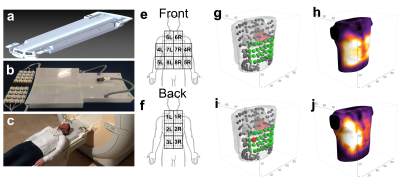 |
20 |
 A 256-channel Cardiac Coil for accelerated Cardiac Imaging at 3 Tesla - Evaluation of a 32-channel Prototype A 256-channel Cardiac Coil for accelerated Cardiac Imaging at 3 Tesla - Evaluation of a 32-channel Prototype
Bernhard Gruber, Arjan Hendriks, Cezar Alborahal, Gustav Strijkers, Dennis Klomp, Tim Leiner, Martijn Froeling
There is an urgent need for highly accelerated cardiac imaging to facilitate shorter examination times and increased patient comfort. The purpose of this study was to investigate if a large number of small surface coils can increase the maximal obtainable acceleration factor, by maximizing SNR and minimizing the g-factor. We demonstrate the potential of a high-density cardiac receive array for faster cardiac imaging compared to current available MR coils. Measurements with a 32-channel cardiac prototype at 3T show a 4-fold increase in acquisition speed at similar SNR. At the cost of a small SNR-drop, 30-fold acceleration factors are possible.
|
|
4291.
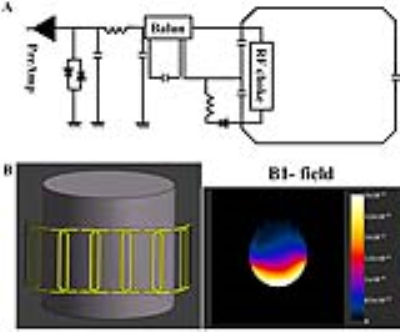 |
21 |
 Ophthalmic magnetic resonance imaging using a 7-channel receive-only phased array coil: Quantitative image evaluation of anatomical orbital structures at 3.0 T Ophthalmic magnetic resonance imaging using a 7-channel receive-only phased array coil: Quantitative image evaluation of anatomical orbital structures at 3.0 T
Kyu-Ho Song, Young Han Lee, Min Jung Kim, Jin-Suck Suh, Bo-Young Choe
The surface coil which yields a higher signal-to-noise ratio only in small area can improve with multi-channel that each channel SNR is combined with a sum-of-squares method. This processing achieves an overall higher SNR in the region of interest (or field of view). In the present study, a 7-channel orbit array coil was developed for ophthalmic imaging. Image quality evaluation by using the designed orbit array coil was examined for imaging the eye, optical nerve, and ocular muscles with orbit.
|
|
4292.
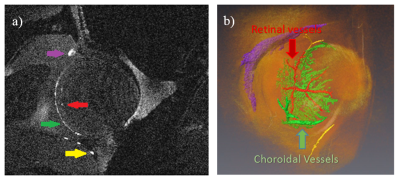 |
22 |
 Establishing MR angiography of the mouse eye Establishing MR angiography of the mouse eye
Gangchea Lee, Kenneth Kim, Thomas Neuberger
High field Magnetic Resonance Angiography on mouse eye can be used to investigate the vasculature near the mouse eye. One of the difficulties with using on mice is the induced moving artifact. To overcome this obstacle, a custom mouse restrainer containing both a tooth bar and ear bars was designed and constructed for mouse eye imaging. The restrainer, in combination with a rigid surface coil, enabled three-dimensional mouse eye images to be captured with 30 um isotropic resolution. A three-dimensional mouse angiography was created by segmenting ocular blood vessels from these images.
|
|
4293.
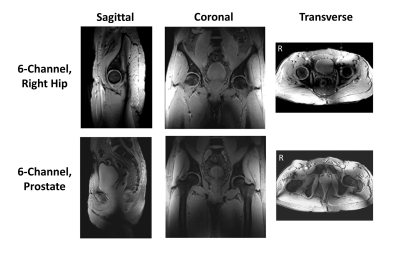 |
23 |
 A Slot Antenna Array for Body Imaging at 7T A Slot Antenna Array for Body Imaging at 7T
Leeor Alon, Karthik Lakshmanan, Jan Paska, Riccardo Lattanzi, Chris Collins
Slot antennas have been shown to be promising for body imaging at Ultra High Field (7T). In this work, a 6-channel transmit-receive slot array was constructed, quantitative evaluation of the performance was conducted and practical design features are discussed.
|
|
4294.
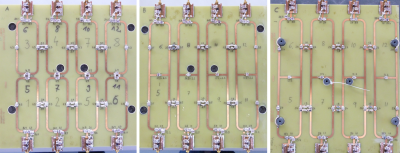 |
24 |
RF Shimming and Improved SAR Safety for 16-Channel Transmit/Receive RF Coil Arrays for Cardiac MRI at 7T
Video Permission Withheld
Ibrahim Elabyad, M. Stefanescu, M. Terekhov, Frank Resmer, Titus Lanz, L. Schreiber
In this work, comprehensive high resolution EM-simulations were performed for three different 16-element transmit/receive (Tx/Rx) planar RF coil arrays loaded with the anatomical Duke human model to examine their performance in cardiac magnetic resonance imaging (cMRI) at 7T. An optimization routine has been developed in MATLAB to optimize the phases for B1+ field homogeneity with minimal local SAR values within the Duke human biological model. Before B1-shimming, all arrays demonstrated approximately the same B1+ field distributions with a pronounced higher field values near to the coil surface. With phase increments of 45° phase shift between each of the 8-element pairs, the arrays generate pronounced local SAR hot spots with maximum values of 10.3, 10.1, and 9.4 W/kg for design 1, 2 and 3, respectively. In accordance with IEC regulations, the calculated 10 g averaged SAR values were found to be within the limits and the relative hot spots were found to be below 11 W/kg. RF shimming improves the B1+ field homogeneity by 24%, 49% and 40% in the central sagittal slice for design 1, 2 and 3, respectively.
|
|
Dielectrics, Metamaterials & Field Control
Electronic Poster
Engineering
Tuesday, 19 June 2018
| Exhibition Hall |
16:15 - 17:15 |
| |
|
Computer # |
|
4295.
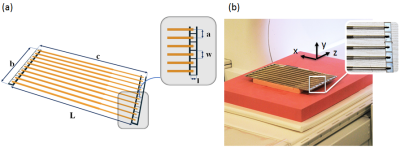 |
25 |
 Compact and adjustable metasurface-based resonator for in-vivo MRI Compact and adjustable metasurface-based resonator for in-vivo MRI
Ekaterina Brui, Alena Shchelokova, Mikhail Zubkov, Irina Melchakova, Stanislav Glybovski, Anna Andreychenko, Alexey Slobozhanyuk
We have numerically and experimentally approved that a compact metasurface-based resonator with miniaturized capacitive load may efficiently operate as a wireless surface coil in 1.5 T MR scanner. Our results show that for a properly adjusted metasurface eigenmode resonance frequency it is possible to substantially increase the signal-to-noise ratio that was confirmed both with the phantom and in vivo experiments.
|
|
4296.
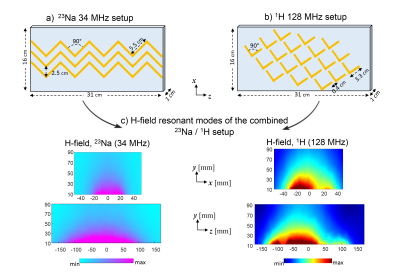 |
26 |
 Dual-nuclei metamaterial implementation for sodium and proton acquisition at 3 T Dual-nuclei metamaterial implementation for sodium and proton acquisition at 3 T
Rita Schmidt, Andrew Webb
Several studies have shown proof-of-principle implementations of metamaterials for local RF transmit efficiency and sensitivity improvement. The most common implementations are based on set of split-rings or set of wires. To support a dual-band enhancement, the design here relies on a combination of the mentioned above two types of metamaterials. Whereas in the original study we focused on 7T 31P/1H dual-band implementation, in this work we were interested to examine the possibility to extend it to much lower frequencies, namely a dual-band metamaterial for 3T 23Na/1H local signal enhancement. The implementation was examined in EM simulations and in phantom experiments at 3 T.
|
|
4297.
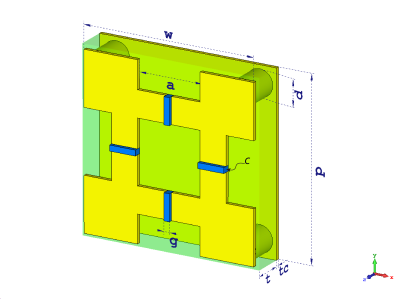 |
27 |
 Metamaterial RF Shield with Reduced Specific Absorption Rate and Improved Transmit Efficiency for 9.4 T MRI Metamaterial RF Shield with Reduced Specific Absorption Rate and Improved Transmit Efficiency for 9.4 T MRI
Haiwei Chen, Lei Guo, Mingyan Li, Chunyi Liu, Shanshan Shan, Yaohui Wang, Ewald Weber, Feng Liu, Stuart Crozier
A novel RF shield using metamaterial absorber was designed for 9.4 T MRI. This new design focuses on improving the transmit efficiency of RF coils and reducing the Specific Absorption Rate (SAR) in the subject. A new layered unit cell structure of metamaterial absorber was used for constructing the RF shield. Full-wave simulation results were presented and compared with a conventional copper RF shield; the results suggest that the proposed structure could achieve improved imaging performance.
|
|
4298.
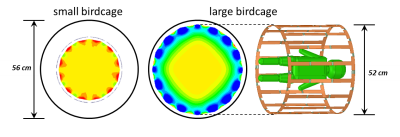 |
28 |
 Metamaterial Bore Liners as High-Field Body Transmit Coils: Advantages Over Standard Birdcage Coils Metamaterial Bore Liners as High-Field Body Transmit Coils: Advantages Over Standard Birdcage Coils
Navid Hosseini, Justin Pollock, Ashwin Iyer, Nicola De Zanche
Simulations are presented of a negative-permittivity metamaterial bore liner designed to perform volume excitation at 200 MHz. The liner offers performance comparable to that of birdcage coils in terms of both field homogeneity, sensitivity and SAR, while allowing operation at frequencies beyond those where birdcage coils operate reliably.
|
|
4299.
 |
29 |
 Evaluation of Different Coupling Schemes for a Dielectric Resonator in Magnetic Resonance Imaging at 600 MHz- a Simulation Approach Evaluation of Different Coupling Schemes for a Dielectric Resonator in Magnetic Resonance Imaging at 600 MHz- a Simulation Approach
Gangchea Lee, Wei Luo, Michael Lanangan, Thomas Neuberger
The TE01δ mode of the ring Dielectric Resonator (DR) is of interest to the high field MRI community for it generates highly homogenous fields over large volumes inside the DR. The ring DRs behave differently depending on the method of coupling. Six different coupling methods using the conducting wire were simulated three dimensionally. Differences in the electromagnetic field inside the DR, depending on the coupling method, were observed in the simulation. These results were interpreted to determine the mechanism producing the highest magnetic field using triple loop coupling.
|
|
4300.
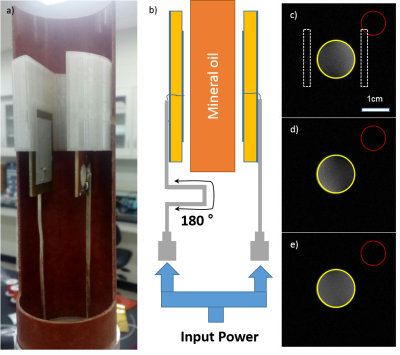 |
30 |
 Double Facing Miniaturized Patch Antennas with High Permittivity Plugs Double Facing Miniaturized Patch Antennas with High Permittivity Plugs
Gangchea Lee, Navid Gandji, Seokwon Jung, Elena Semouchkina, Michael Lanangan, Thomas Neuberger
Substituting the conventional Radio Frequency coil (RF coil) with a patch antenna has the potential to increase the magnetic field homogeneity in large Fields Of View (FOV). The homogeneity can be improved even more when two of these antennas are facing each other. The size of the patch antennas needed to be reduced to fit inside the scanner bore to use them as RF coils. This was done via inserting high dielectric material plugs. The two facing patch antennas system was also fabricated and tested.
|
|
4301.
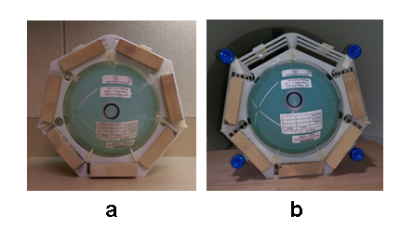 |
31 |
 Possibilities for local SAR Reduction with uHDC Material & 2 Ch pTX Possibilities for local SAR Reduction with uHDC Material & 2 Ch pTX
Christopher Sica, Sebastian Rupprecht, Ryan Hou, Qing Yang
Variation of the RF transmit field polarization in conjunction with the application of a uHDC monolithic block was explored within the context of reducing local SAR, through RF field simulations and B1+ mapping. A linear polarization in conjunction with a discrete uHDC block was found to substantially reshape the null band in the electric field, which opens new possibilities for local SAR reduction.
|
|
4302.
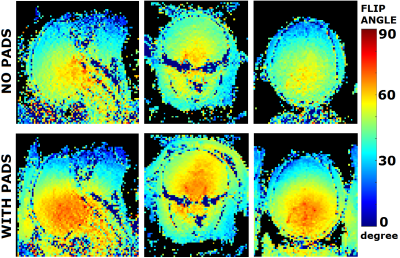 |
32 |
Evaluation of High-dielectric Pads for Macaque Brain Imaging at 7T: A Pilot Study
Video Permission Withheld
Jie Zhao, Wei Luo, Meizhen Qian, Yi Sun, Ling Xia, Xiaotong Zhang
Non-human-primates are a valuable model for investigating the structure and function of the brain. The high-dielectric pads have been shown to increase B1 sensitivity and enhance image SNR and contrast locally in the human brain at high and ultra-high field. In this study, our pilot experiment results suggest that high-dielectric pads can effectively enhance macaque whole brain imaging at 7T, and in the meantime, do not increase the receive array element coupling, nor have any deterioration over the B0 homogeneity within the monkey brain.
|
|
4303.
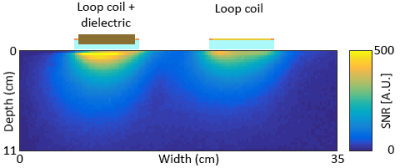 |
33 |
 Low-loss high-permittivity blocks improves the signal-to-noise ratio of surface coils at 3 Tesla Low-loss high-permittivity blocks improves the signal-to-noise ratio of surface coils at 3 Tesla
Thomas O'Reilly, Wyger Brink, Andrew Webb
The performance of surface coils for proton imaging at 3 Tesla can be improved by placing low-loss high-permittivity blocks at the centre of the surface coil. The signal-to-noise ratio in a human calf of a coil with integrated dielectric block is 25% higher close to the coil and performs comparably well compared to a standard surface coil at depths exceeding 6 cm providing a simple and effective way of improving surface coil performance.
|
|
4304.
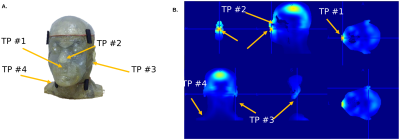 |
34 |
 An electrically conductive SLA resin used for the Design of Anthropomorphic Phantoms An electrically conductive SLA resin used for the Design of Anthropomorphic Phantoms
Sossena Wood, Tiago Martins, Tales Santini, Tamer Ibrahim
In this work, we have researched the possibility of using a conductive plastic that is suitable for the design of an anthropomorphic phantom for MR testing purposes. DSM Somos® provides a clear hydrophobic SLA resin that has constitutive parameters similar to the averaged electromagnetic properties of the fat, bone, and skin. The work of Wood et al.1 highlighted these findings using numerical B1 analysis. To further examine the electrically conductive plastic SLA resin material, we performed temperature testing on areas of the plastic material where we estimated temperature rise using a TEM resonator at 7T.
|
|
4305.
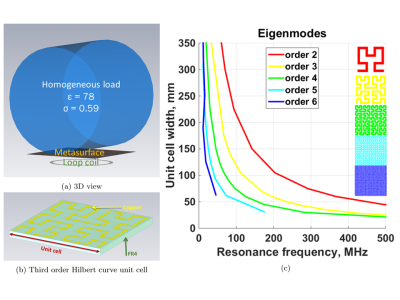 |
35 |
 A Hilber Curve Based Metasurface for B1+-field Enhancement A Hilber Curve Based Metasurface for B1+-field Enhancement
Elizaveta Motovilova, Shao Ying Huang
A novel metasurface field enhancer based on Hilbert curve is presented. Its resonance behavior was studied and the B1-field enhancement with field symmetry is successfully demonstrated at 7T. On a simple loop coil model, it is shown that higher orders of Hilbert curve can form metasurfaces that increase the coil sensitivity effectively.
|
|
4306.
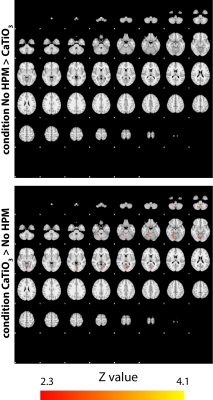 |
36 |
 Improved Efficacy of Cerebellar fMRI at 7T with Dielectric Pads Extending the Imaging Region of a Commercial Head Coil Improved Efficacy of Cerebellar fMRI at 7T with Dielectric Pads Extending the Imaging Region of a Commercial Head Coil
Manushka Vaidya, Mariana Lazar, Cem Deniz, Gillian Haemer, Gang Chen, Mary Bruno, Daniel Sodickson, Riccardo Lattanzi, Christopher Collins
To improve cerebellar fMRI using a commercial head coil at 7T, we arranged High Permittivity Material (HPM) pads against the inferior, posterior region of the head. We first simulated the change in Specific energy Absorption Rate (SAR) with HPM and then examined the effects on experimental Signal to Noise Ratio (SNR), flip angle maps, and measured fMRI activation throughout the brain (including the cerebellum) during a finger-tapping task in eight subjects. Both SNR and fMRI BOLD contrast were improved in the cerebellum with no potential safety detriments.
|
|
4307.
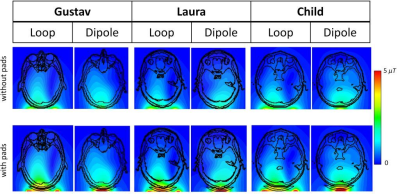 |
37 |
 Dielectric pads for high-field MRI at 7T: a simulation study Dielectric pads for high-field MRI at 7T: a simulation study
Shubharthi Sengupta, Alard Roebroeck
Dielectric pads have been shown to offer a solution to B1+ inhomogeneity at ultra-high fields. We show the transmit field effects and SAR values generated when using shape-optimised high permittivity dielectric pads for visual cortex imaging. Using a single loop coil and a single dipole, electromagnetic simulations were undertaken to validate the use of these methods using 3 different body voxel models, their B1+ distributions mapped and maximum SAR values recorded and compared.
|
|
4308.
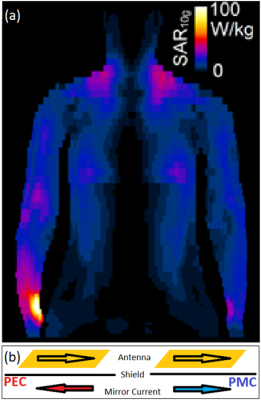 |
38 |
 Improved performance of birdcage coils using a split-ring resonator magnetic shield. Improved performance of birdcage coils using a split-ring resonator magnetic shield.
Carel van Leeuwen, Martijn Lunenburg, Stanislav Glybovski, Peter Luijten, Dennis Klomp, Cornelis van den Berg, Alexander Raaijmakers
Birdcage body coils make use of an RF shield that degrades B1 homogeneity of the birdcage and increases SAR levels in body parts close to the rungs. A magnetic conductor RF shield would solve this issue. A metamaterial structure of elongated split-ring resonators (SRR) was designed to achieve an artificial magnetic conductor. Simulations and measurements with planar SRR arrays over a dipole are performed. Increased B1+ penetration into phantoms is observed, indicating the shield behaves as a magnetic conductor. Additionally simulations of a birdcage antenna with such shield are performed, which show an improved B1 homogeneity with comparable SAR levels.
|
|
4309.
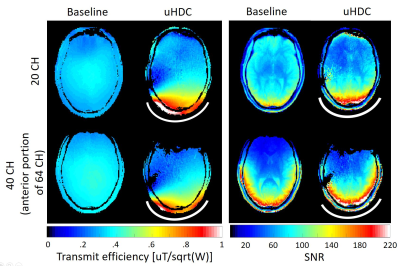 |
39 |
 Towards high resolution fMRI at 3T with a flexible composite ultra-high dielectric constant (uHDC) material pad Towards high resolution fMRI at 3T with a flexible composite ultra-high dielectric constant (uHDC) material pad
Sebastian Rupprecht, Christopher Sica, Jianli Wang, Gary Yang, Avery Wang, Michael Lanagan, Qing Yang
We developed a novel flexible pad of uHDC material and characterized the RF fields in the visual cortex at 3T in a clinical 20- and 64-channel head coil with and without this pad. This pad was then utilized in an attempted to visualize optical dominance columns via high resolution fMRI images of the visual cortex in the 20-CH head coil and compared the results of with the results of an unenhanced 64-CH head coil.
|
|
4310.
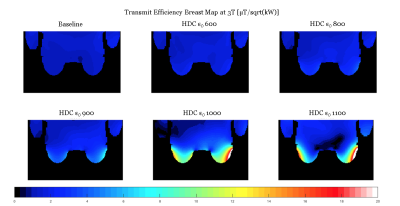 |
40 |
 Initial Evaluation Utilizing Ultra-High Dielectric Constant (uHDC) Materials in Breast Imaging in 3T Initial Evaluation Utilizing Ultra-High Dielectric Constant (uHDC) Materials in Breast Imaging in 3T
Avery Wang, Sebastian Rupprecht, Christopher Sica, Angela Choe, Susann Schetter, Julie Mack, Qing Yang
We explored the feasibility of using high dielectric constant materials to potentially further enhance signal-noise-ratio (SNR) in breast MRI. Through computer modelling at 3 Tesla (T), we showed that there can be great benefits of increasing sensitivity and specificity of breast MRI. As a side effect of using high dielectric constant materials, the RF safety can be improved by the largely increased transmit efficiency.
|
|
4311.
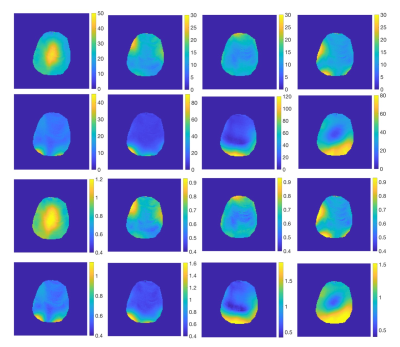 |
41 |
 Bloch-Siegert Shift Based Method for Mapping $$$B_1^+$$$ Magnitude of Arbitrary Multi-Transmit RF Configurations Bloch-Siegert Shift Based Method for Mapping $$$B_1^+$$$ Magnitude of Arbitrary Multi-Transmit RF Configurations
Omer Oran, L. Klassen, Hacene Serrai, Ravi Menon
Mapping B1+ magnitude fields for any arbitrary RF-configuration of interest is desirable and often required in parallel multi-transmit systems. Conventional mapping methods work by taking either the magnitude ratio or the phase difference of MRI images, and thus they fail in regions of low MRI-signal which can easily occur for an arbitrary RF-configuration. We propose a new BSS based method which always uses the CP-mode for excitation while the RF-configuration of interest is used only for the off-resonance RF-pulse. Through this approach, the proposed method works even if the RF-configuration of interest has very-low magnitudes within the imaging volume.
|
|
4312.
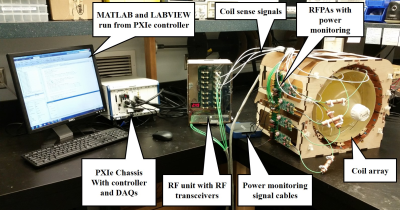 |
42 |
 16 Channel Coupled Network Analyzer for Characterizing pTX Systems at 3T 16 Channel Coupled Network Analyzer for Characterizing pTX Systems at 3T
Michael Twieg, Sherry Huang, Mark Griswold
Recent work has shown parallel RF transmit (pTX) chains with increasing channel counts and complexity. At the same time, methods of controlling and monitoring pTX chains must improve, especially when faced with nonlinearities in the RFPAs. However, characterizing multichannel nonlinear RF systems is a daunting task for standard laboratory instruments. Here we present a coupled network analyzer (CNA) containing 16 independent RF transceivers which are used simultaneously by a digital acquisition unit (DAQ). Additional DAQ channels can be used for monitoring power consumption or temperature. The system may also be interfaced with an MRI scanner to function as a pTX synthesizer.
|
|
4313.
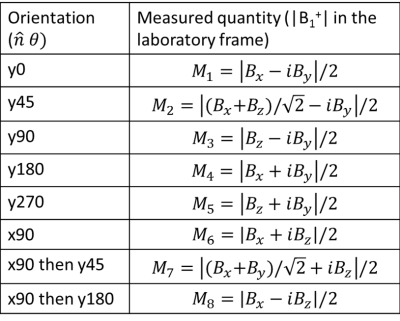 |
43 |
 B1 vector field mapping through multi-orientation B1+ measurements B1 vector field mapping through multi-orientation B1+ measurements
Seung-Kyun Lee, Sukhoon Oh
We present theory and experimental validation of reconstruction of all three components of RF vector magnetic field (B1 vector) in MRI. Using eight-orientation B1+ magnitude mapping, the magnitudes and relative phases of all Cartesian components of B1 vector can be unambiguously determined. The method is demonstrated on a phantom in a birdcage transmit coil with a standard B1+ mapping sequence at 3T. Our method can be used to validate assumptions in MR-based electrical properties tomography (MR-EPT) and specific absorption rate (SAR) modeling.
|
|
4314.
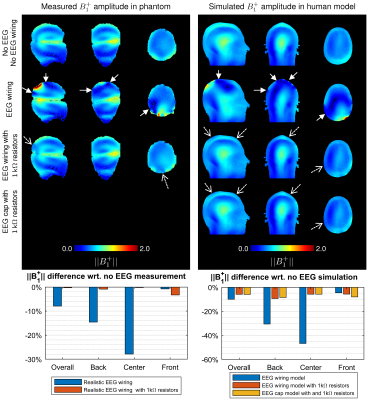 |
44 |
 Improved Transmit Field Homogeneity in Simultaneous EEG-fMRI at 7T by Increasing EEG Wire Resistance Improved Transmit Field Homogeneity in Simultaneous EEG-fMRI at 7T by Increasing EEG Wire Resistance
Thanh Phong Lę, Özlem Ipek, Joăo Jorge, Rolf Gruetter
Simultaneous EEG-fMRI offers rich multimodal information of brain activity. However, data quality is adversely affected by mutual interactions. Especially at higher magnetic fields, conductive scalp EEG components cause substantial transmit field disruption. Here, electromagnetic field simulations and MR measurements at 7T performed on a realistic design of the wiring of a 64-channel EEG cap showed that transmit field attenuation and inhomogeneity are significantly reduced when wires are split into smaller lengths by resistors, suggesting a cancellation of resonant antenna effects. This offers an effective and practical solution to avoid EEG-induced MRI data degradation, maximizing the sensitivity benefits available at 7T.
|
|
4315.
 |
45 |
 Decomposition of off-resonance fields in brain MRI Decomposition of off-resonance fields in brain MRI
Pei-Yan Li, Pu-Yeh Wu, Yi-Tien Li, Ying-Hua Chu, Fa-Hsuan Lin
We measured the off-resonance distributions from 31 subjects and decomposed these maps into orthogonal modes by Singular Value Decomposition. We found that the six SVD modes can account for the off-resonance up to 80%. Decomposed modes of off-resonance can be used for tailored shim coil design.
|
|
4316.
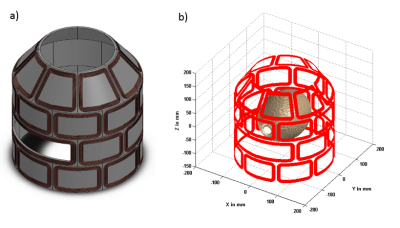 |
46 |
 Development of Multi-Coil B0 Technology with Computer-Aided Design Software Development of Multi-Coil B0 Technology with Computer-Aided Design Software
Sebastian Theilenberg, Yun Shang, Sragvi Tirumala, Christoph Juchem
The multi-coil (MC) technique proved to enable both B0 shimming and spatial encoding for MRI. However, to eventually establish this technology for clinical use in human subjects, it has to evolve from a proof of concept level to a professional stage. Here we present the use of computer aided design (CAD) software to overcome increased engineering challenges that are associated with complex coil geometries and larger coil currents. A customized Add-in for SolidWorks was created to convert MC designs from the text-based Public MC Information Policy format to full CAD representations and vice versa, thereby providing improved field modeling and engineering capabilities.
|
|
4317.
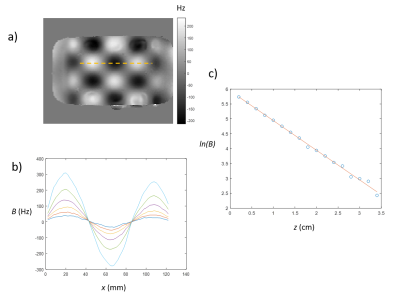 |
47 |
 Novel crusher coils for elimination of surface MR signals Novel crusher coils for elimination of surface MR signals
Richard Bowtell, Harry Ellis
There are multiple applications of magnetic resonance imaging and spectroscopy for which it is useful to be able to attenuate the signal that arises from surface structures. Surface signal can be attenuated by using local coils which generate a spatially varying magnetic field that decays rapidly with distance from the surface. In previous work, crushing has been accomplished by using “meander-line” coils which the current flow is predominantly along one dimension. Here we design novel crusher coils in which the current equally flows along two orthogonal directions, and demonstrate via simulations and experiments at 3 T that these coils offer advantages for surface signal crushing.
|
|
4318.
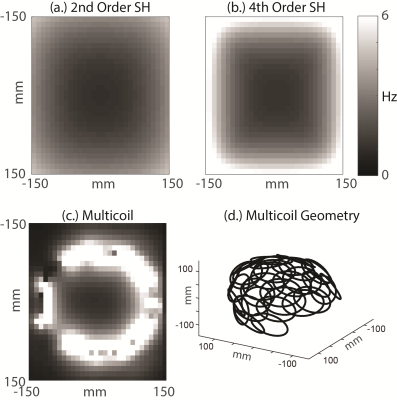 |
48 |
 The Effect of Noise on B0 Shimming: Is There a "g-Factor" for Shim Coils? The Effect of Noise on B0 Shimming: Is There a "g-Factor" for Shim Coils?
Assaf Tal
Active B0 shimming involves setting currents through a set of shim coils to minimize spatial heterogeneity of B0 over a prescribed region. This is often phrased as a least-squares problem, based on an acquired field map. Noise in the field map "propagates" and appears as spatially dependent noise in the shimmed field. We show that the shim coils can be characterized by a noise propagation matrix, which is an intrinsic property of the coils and plays an analogous role to the g-factor in sensitivity encoding. This provides a useful metric for investigating the effect of noise in active shimming.
|
|
Simulations & Modeling
Electronic Poster
Engineering
Tuesday, 19 June 2018
| Exhibition Hall |
17:15 - 18:15 |
| |
|
Computer # |
|
4390.
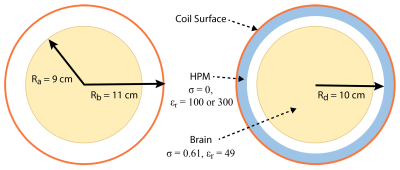 |
1 |
 Exploring the performance of high density detector coil arrays at 10.5 Tesla Exploring the performance of high density detector coil arrays at 10.5 Tesla
Riccardo Lattanzi, Manushka Vaidya, Daniel Sodickson, Kamil Ugurbil, Gregor Adriany
We used a uniform sphere to model the human head and investigated the performance of receive loop arrays for brain imaging at 10.5T to evaluate the advantage of using a large number of detectors, both alone and in combination with high-permittivity materials (HPM). We show that the ultimate intrinsic signal-to-noise ratio in the central region could be approached with a relative small number of loop coils, whereas more elements are needed to maximize SNR near the surface and to achieve large acceleration factors. Superficial SNR at 10.5T could be considerably enhanced using HPM fairly easy to achieve in practice.
|
|
4391.
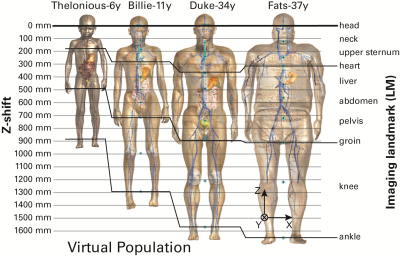 |
2 |
 Virtual Population Based Correlations between B1+, Whole-Body and Local SAR Virtual Population Based Correlations between B1+, Whole-Body and Local SAR
Manuel Murbach, Earl Zastrow, Niels Kuster
Knowledge about the relationship between B1+rms and SAR is beneficial for the MRI RF safety community, consisting of academic investigators, MRI and implant vendors, and regulatory bodies. While implant manufacturers have already started to shift device-labelling form SAR to B1+rms, there is not yet available a systematic evaluation of their relationship. In this study, we aim to close this gap by presenting a systematic methodology for numerical estimations of an entire exposure-scenario matrix, including various human anatomical models, imaging positions, and MRI body-coil geometries.
|
|
4392.
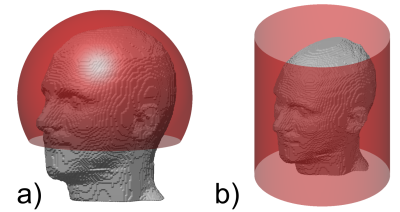 |
3 |
About the Ideal Receive Array for Human Head MRI
Did Not Present
Andreas Pfrommer, Anke Henning
For the first time, we present a systematic framework to assess the intrinsic SNR performance of loop-only and dipole-only receive arrays in a realistic human head model. Thereby, we distribute generic current patterns on a helmet-like and a cylindrical coil holder. These current patterns form a basis set for any kind of receive element one could place on the holder. We demonstrate how to design an ideal receive array for human head applications by using complementary current patterns.
|
|
4393.
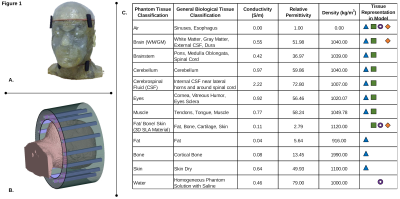 |
4 |
 Comparison of Electric and B1+ Fields for Heterogeneous and Homogeneous Anthropomorphic Phantoms and Anatomical Models: Numerical Simulations and Experimental Findings Comparison of Electric and B1+ Fields for Heterogeneous and Homogeneous Anthropomorphic Phantoms and Anatomical Models: Numerical Simulations and Experimental Findings
Sossena Wood, Tales Santini, Narayanan Krishnamurthy, Tiago Martins, Tamer Ibrahim
While numerical phantoms and detailed human tissue models have been available for some time in MR1-5, the development of experimental phantoms has yet to fully evolve. The growth of rapid prototyping and mimicry of tissues through tissue engineering is making it more possible for realistic electromagnetic phantoms that mimic human anatomy to be available to MR researchers and their collaborators. Wood et al. 6 fabricated a realistic head model (shown in Figure 1A) that can be used for a wide-variety of MR purposes and builds on the work of Gradel et al.7. However, the argument can still be made as to how beneficial it is to have a heterogeneous anthropomorphic phantom in place of a homogeneous anthropomorphic phantom. We hypothesize that the differences will be greatest in the electric field intensities and distribution as opposed to the B1+ field. In this work, we perform numerical studies and experimental 7T measurements that highlight the differences in the electric field and magnetic field of an anthropomorphic phantom (computer model as well as 3D printed) filled with homogeneous and heterogeneous media in comparison to a 10-tissue segmented head model. The phantom uses a resin plastic material that approximates the electromagnetic constitutive properties of a combination fat, bone and skin.
|
|
4394.
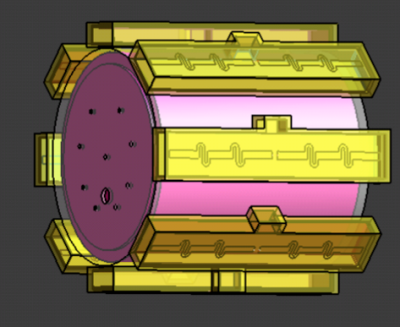 |
5 |
 Platform for Validating pTx RF Coil Simulations Using Proton Resonance Frequency Shift MR Thermometry Platform for Validating pTx RF Coil Simulations Using Proton Resonance Frequency Shift MR Thermometry
Hongbae Jeong, Matthew Restivo, Peter Jezzard, Aaron Hess
We propose a workflow to validate parallel transmission (pTx) RF heating patterns using Proton-Resonance Frequency shift (PRF)-based MR thermometry. An agar+polyethylene powder cylindrical phantom, with similar dielectric properties to the human brain at 297.2 MHz, was designed to assess an 8-channel dipole array. RF heating was evaluated and compared between PRF-based MR thermometry, fibre optic probe measurement, and thermal simulation. The PRF reconstruction procedure was optimized to reduce artefacts. Given the importance of RF safety in pTx applications, this method enables accurate validation of RF heating simulations with minimal additional hardware requirements.
|
|
4395.
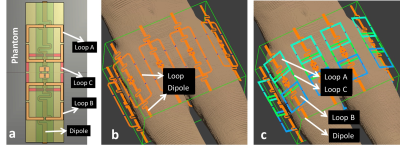 |
6 |
 An improved 32-channel loop-dipole transceiver array design for body imaging at 7.0 Tesla: Simulation study An improved 32-channel loop-dipole transceiver array design for body imaging at 7.0 Tesla: Simulation study
M. Arcan Erturk, Xiaoping Wu, Gregor Adriany, Russell Lagore, Kamil Ugurbil, Gregory Metzger
An improved 32-channel transmit/receive (transceiver) body array (32LD) is designed by combining eight fractionated dipole elements with 24 loops, 3 each stacked lengthwise above each dipole. Performance of the 32LD is compared against a 16-channel loop-dipole (16LD) array through numerical modeling/simulations around the pelvis and torso of a male human model. The 32LD has ~10% SNR gain in deep centrally located tissues (prostate), >20% gain in medium-depth imaging targets (kidneys) and >30% near the surface. The 32LD has improved field-uniformity, higher transmit efficiency, comparable SAR to 16LD with phase-only RF shimming; and improved excitation fidelity with multi-band parallel transmit pulses.
|
|
4396.
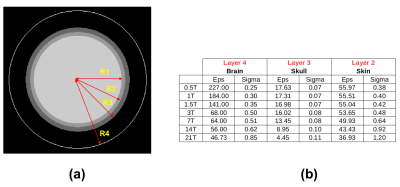 |
7 |
 Exploring how modeling the head as a multi-layered vs. uniform sphere affects ultimate intrinsic signal-to-noise ratio and coil performance prediction Exploring how modeling the head as a multi-layered vs. uniform sphere affects ultimate intrinsic signal-to-noise ratio and coil performance prediction
Jonghyun Bae, Manushka Vaidya, Riccardo Lattanzi
We investigated differences in ultimate intrinsic SNR and simulated SNR for finite coils when modeling the human head as a single-layer uniform sphere with average brain electrical properties vs. a three-layer sphere that accounts also for skull and skin tissue. We show that the uniform sphere provides a good approximation of the head for simulations up to 3T, but becomes less accurate at ultra-high field strengths.
|
|
4397.
 |
8 |
 Improving breast imaging B1+ homogeneity with B1 shimming at 1.5T: a modeling study Improving breast imaging B1+ homogeneity with B1 shimming at 1.5T: a modeling study
Xin Chen, Xin Li, Danielle Kara, Mingdong Fan, Joseph Rispoli, Michael Steckner, Robert Brown
B1+ inhomogeneity is a challenge for breast imaging and B1 shimming is standard for all 3T clinical MRI applications. While B1+ homogeneity is typically better at 1.5T than 3T due to reduced wavelength effects, breast image quality is still challenged by B1+ inhomogeneity at 1.5T. This work shows B1 shimming can significantly improve B1+ homogeneity for breast imaging at 1.5T as compared to conventional quadrature drive.
|
|
4398.
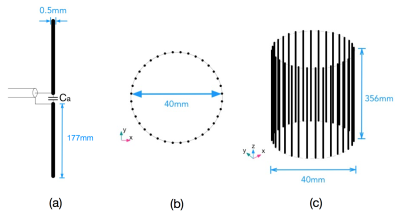 |
9 |
 Feasibility exploration of constructing volume RF coil with coupled dipole antennas at 9.4T Feasibility exploration of constructing volume RF coil with coupled dipole antennas at 9.4T
Shasha Yue, Chao Luo, Nan Li, Jo Lee, Qiaoyan Chen, Ye Li, Xiaoliang Zhang
Dipole antenna, a simple resonator structure, has demonstrated a unique capability of achieving high resonant frequency and utility in MR imaging. Theoretically, this simple resonator structure could be advantageous for building non-array volume RF coil design for ultrahigh field MR imaging applications. In this work, we explore the feasibility of using dipole antenna as resonant element to design non-array volume coils for the ultrahigh field 9.4T MR imaging. The results show that the dipole antennas have sufficient coupling among the resonator elements to create multi-mode resonances and form uniform B1 field distribution within the volume coil at 400 MHz.
|
|
4399.
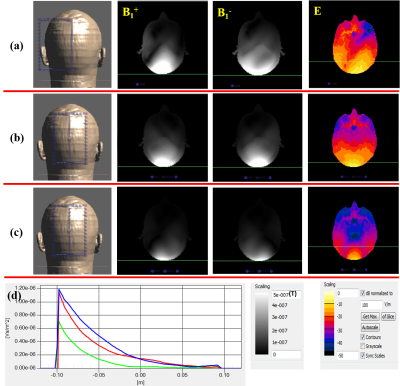 |
10 |
 Simulation study about New RF loop coil with homogenous 7T B1 field Simulation study about New RF loop coil with homogenous 7T B1 field
Seunghoon Ha, Adam Morris, Jonathan Nass
A loop coil design with homogenous B1 field and competitive sensitivity for 7T MRI was presented. The proposed coil was able to align on ROI unlike the asymmetric segmented loop coil design. The calculated B1 field uniformity and coil sensitivity of the proposed coil was superior to the asymmetric segmented loop coil as well as the loop coil with symmetrically distributed capacitors. The eight channels volume shaped loop array constructed by the proposed design loops was simulated. The proposed design will potentially help the construction of larger size loop arrays to cover more imaging volume at 7T and higher.
|
|
4400.
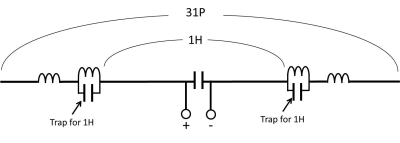 |
11 |
 Design and simulation of dual-band dipole antenna for 1H/31P at 9.4T MRI Design and simulation of dual-band dipole antenna for 1H/31P at 9.4T MRI
Suk-Min Hong, Chang-Hoon Choi, Jörg Felder, N. Shah
The resonance frequency of a dipole antenna is defined by its length (λ/2). The use of LC traps at specific locations within the dipole antenna generates additional resonances. We designed a dual-band dipole antenna tuned to 400 MHz for 1H and 160 MHz for 31P with the aid of an LC trap. The length of the dipole antenna was shortened to 32 cm by introducing end meanders and this concept was also expanded to form a 4-channel array. The performance of the dual-band dipole antenna was simulated and the feasibility of using it as an antenna array is demonstrated.
|
|
4401.
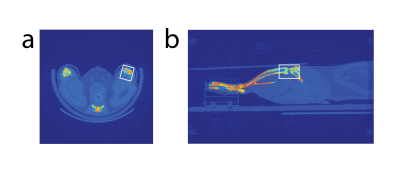 |
12 |
 Fast Optimization Method for RF Coil Array Geometry in a Post-Processing Step Fast Optimization Method for RF Coil Array Geometry in a Post-Processing Step
Jan Paska, Amparo Ruiz, Jose Raya
In this work we propose a novel single-run simulation method for RF coil design spanning enough of the design space to provide a clear intuition on optimal coil design, offer a benchmark SNR, and predict coil losses and coupling. It is based on the combination of conductors and sources to emulate coil arrays in a post-processing step. We demonstrated our method's potential for the optimization of an RF coil array for imaging of the rat limb at 7T. We validated our method using electromagnetic (EM) field simulations.
|
|
4402.
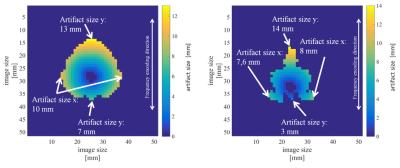 |
13 |
 Validation of numerical simulation of susceptibility artifact and the consequences for artifact size calculation of the current ASTM standard F2119 Validation of numerical simulation of susceptibility artifact and the consequences for artifact size calculation of the current ASTM standard F2119
Tobias Spronk, Archana Chinnaiyan, Jakob Kreutner, Gregor Schaefers
The ASTM standard F2119 provides evaluation methods for the artifacts of medical implants in a well-defined test environment. In our work we had validated a numerical simulation of MR susceptibility artifacts according to this standard. Based on this simulation, the calculation methods of the artifact size in the ASTM standard were evaluated to show the limitation of the current methods.
|
|
4403.
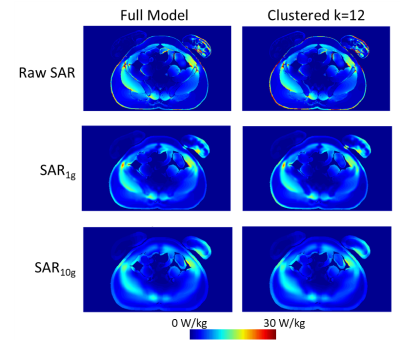 |
14 |
 Simplifying the Numerical Human Model with k-means Clustering Method Simplifying the Numerical Human Model with k-means Clustering Method
Kyoko Fujimoto, Leonardo Angelone, Sunder Rajan, Maria Ida Iacono
Currently, the safety assessment of radio-frequency (RF) heating in computational modeling is limited by the available numerical models which are not patient-specific although RF-induced heating depends on the physical characteristics of the patient. The numerical model generation is difficult due to the highly time-consuming segmentation process. Therefore, having fewer types of segmented structures simplifies the generation of numerical models. In this study, we used the k-means clustering method to reduce the number of dielectric properties of an existing numerical model and investigated the resulting difference in SAR with respect to the number of clusters.
|
|
4404.
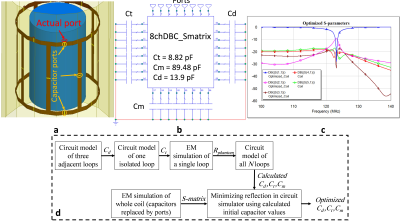 |
15 |
 Accelerating the Co-Simulation Method for Fast Design of Transmit Array Coils: An Example Study on a Degenerate Birdcage Coil Accelerating the Co-Simulation Method for Fast Design of Transmit Array Coils: An Example Study on a Degenerate Birdcage Coil
Alireza Sadeghi-Tarakameh, Ehsan Kazemivalipour, Taner Demir, Umut Gundogdu, Ergin Atalar
The co-simulation method suffers local minima during the design of a transmit array coils. In this study, our purpose is to utilize an equivalent circuit model of the coil and analytical calculations to provide a proper initial guess for co-simulation method. For the proof of concept, we designed and constructed an eight-channel head-degenerate birdcage coil (DBC) for a 3T scanner using this method which decreased the optimization time by more than 6000 fold.
|
|
4405.
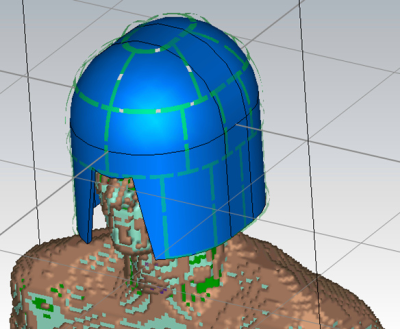 |
16 |
 SNR Evaluation for a high-permittivity dielectric helmet-shaped coil former for a 28 channel receive array SNR Evaluation for a high-permittivity dielectric helmet-shaped coil former for a 28 channel receive array
Giuseppe Carluccio, Gillian Haemer, Manushka Vaidya, Sebastian Rupprecht, Qing Yang, Christopher Collins
The performance of a high-permittivity helmet-shaped former is evaluated when used to improve the SNR in the head for a 28-channel receive array coil. Through simulations, it was found that the use of the helmet can dramatically increase the SNR in the head, up to more than 3 times the original value in some locations of the head, and about 50% increase overall in the brain.
|
|
4406.
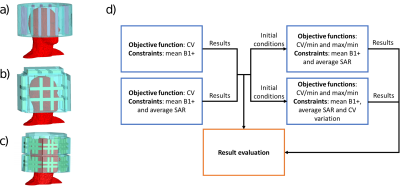 |
17 |
 New optimization strategies for RF shimming at UHF MRI New optimization strategies for RF shimming at UHF MRI
Tales Santini, Sossena Wood, Narayanan Krishnamurthy, Yutong Zhang, Nadim Farhat, Neilesh Vinjamuri, Minseok Koo, Howard Aizenstein, Tamer Ibrahim
This work proposes four optimization strategies for the RF shimming in UHF MRI. The results show a minimum coefficient of variation of B1+ field distribution over the human head = 23%/17%/14% for the 4chTEM, 16chTTT, and 64chTTT respectively. For the maximum over minimum evaluation criteria of the B1+ field distribution, the best values were 6.70/2.92/2.23 for 4chTEM/16chTTT/64chTTT coils. For a fixed mean B1+ field over the human head, the best average SAR values were 2.09/1.28W/kg for the 4chTEM/16chTTT coils respectively. These strategies can be applied to any RF transmit array system, but are most beneficial for highly parallel systems.
|
|
4407.
 |
18 |
 Evaluation of RF Shielding Effectiveness by Method of Moments Evaluation of RF Shielding Effectiveness by Method of Moments
Yihe Hua, Teck Beng Desmond Yeo, Thomas Foo, Dominic Graziani, Justin Ricci, Joseph Piel, Keith Park
In MRI system, RF shielding is designed to isolate the RF coil from outside conductive objects. Usually simulation is done with only RF coil and RF shielding being included and the impact from outside objects could be qualitatively estimated by limiting the fringe field of the RF coil to a certain level. In this work, the impact from gradient coil to the RF coil can be examined quantitatively rather than qualitatively via the S-parameters of the RF coil being studied with Method of Moments. which is very useful for the RF shielding design.
|
|
4408.
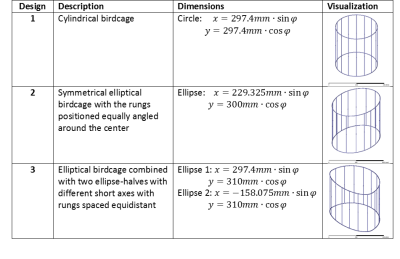 |
19 |
 Development of an Asymmetrical Birdcage Design towards Homogeneous Volume Excitation for Hyperpolarized Xenon-129 Lung Imaging at 3T Development of an Asymmetrical Birdcage Design towards Homogeneous Volume Excitation for Hyperpolarized Xenon-129 Lung Imaging at 3T
Wolfgang Loew, Christopher Ireland, Zackary Cleveland, Hui Wang, Peter van der Meulen, Randy Giaquinto, Ronald Pratt, Jason Woods, Charles Dumoulin
Hyperpolarized 129Xe imaging is increasingly viewed as a viable tool for assessing lung structure and function. 129Xe MRI requires that large flip angle and frequency selective RF pulses be applied homogeneously across the entire thorax. The transmit performance of three common multi-nuclear whole-body birdcage designs was assessed under a loaded condition at different locations inside the RF shield with electromagnetic field simulations. The acquired data was used to develop a novel, optimized birdcage design for which the transmit performance was analyzed and compared to the three common designs.
|
|
4409.
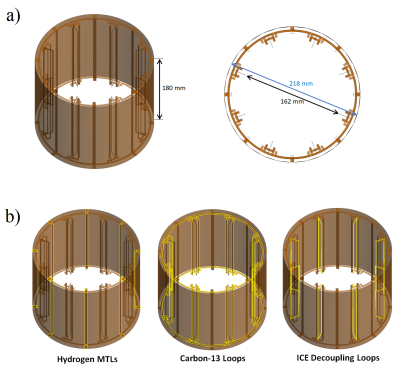 |
20 |
 Computer-aided design and simulation of a double-nuclear parallel transmit RF coil array for proton MRI and carbon-13 MRS of human extremities at 7T Computer-aided design and simulation of a double-nuclear parallel transmit RF coil array for proton MRI and carbon-13 MRS of human extremities at 7T
Omar Rutledge, Riccardo Stara, Brian Rutt
13C MR spectroscopy can offer important metabolic information in the musculoskeletal system without the use of ionizing radiation. In this work, we design and simulate a novel double-nuclear pTx RF coil array (8-channel per frequency) with ICE decoupling coils for proton MRI and 13C MRS of human extremities. Coupling was compared between the RF coil array with and without ICE elements demonstrating the significant decoupling effect of the ICE coils. Calculated B1+ field maps for both the proton MTLs and the 13C loops with ICE elements show sufficient transverse magnetization for MRI and MRS applications. Through the use of switch-tuned ICE decoupling elements, we have demonstrated the feasibility of dual-frequency pTx arrays for 1H imaging and 13C spectroscopy of human extremities at 7T.
|
|
4410.
 |
21 |
High Density Volume Array Strategies for SNR and Parallel MRI
Video Permission Withheld
Scott King, Zhiyong Zhai
Most receive array coils are made of many various shapes of loop coils with different arrangements. In practice, the final goal for a good performance array coil is to find a combination of these loop coils such that improved optimal signal-to-noise ratio (SNR)1-3 and reduced parallel MRI g-factor3 can be achieved in the same time. Here we study four different loop coil arrangements for a head array coil. The simulation results shed some light on optimal loop arrangements and performance expectations.
|
|
4411.
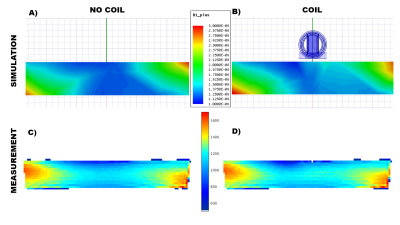 |
22 |
 Combined EM simulations and measurements of birdcage coil B1+ for designing a 3T multichannel TMS /MRI head coil array Combined EM simulations and measurements of birdcage coil B1+ for designing a 3T multichannel TMS /MRI head coil array
Lucia Navarro de Lara, Laleh Golestani Rad, Sergey Makarov, Jason Stockmann, Lawrence Wald, Thomas Witzel, Aapo Nummenmaa
The multichannel TMS approach enables steering the stimulation “hot spot” electronically making the execution of concurrent TMS and fMRI experiments potentially more flexible. An integrated multichannel TMS/MRI system is currently under development and here we investigate how TMS coils influences the B1+ field of a birdcage coil. We compare detailed electromagnetic simulations with empirical data using a single three-axis TMS coil element as well as generate simulated data for 4x4 TMS coil array. Both simulations and empirical results indicate that an array of TMS coils should not distort the B1+ significantly at distances bigger than 2cm from the coil.
|
|
4412.
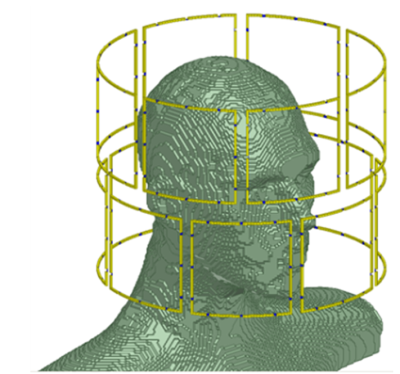 |
23 |
 Reverse Engineering of a 7T 16-Channel Dual-Row Transmit Array Coil Reverse Engineering of a 7T 16-Channel Dual-Row Transmit Array Coil
Mikhail Kozlov, Nikolaus Weiskopf, Harald Möller, Gunamony Shajan
We developed a reverse engineering numerical workflow that yielded a good match between measured and simulated scattering parameters of an inductively decoupled non-overlapped dual-row transmit array for MRI at 7T. We evaluated and compared the performance of different tuning conditions resulted in similar scattering parameters. For the circular polarization mode under-coupled, over-coupled, or mixed tuning conditions resulted in up to 65% variation of different coil losses but small variation of transmit efficiency. For comparisons of array transmit performance, consideration of array-internal losses as well as reflected and radiated power is very important, because their sum can be as high as 71% of the total transmit power.
|
|
4413.
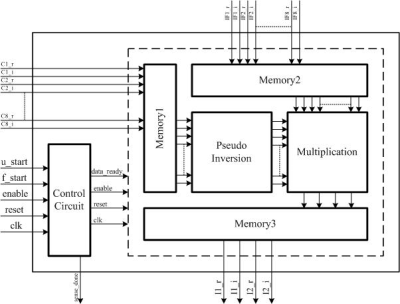 |
24 |
 ASIC Model of SENSE to Accelerate MR Image Reconstruction ASIC Model of SENSE to Accelerate MR Image Reconstruction
Sohaib Qazi, Faisal Siddiqui, J Wikner, Hammad Omer
In Parallel MRI (pMRI), imaging process is accelerated by acquiring less data using multiple receiver coils and offline reconstruction algorithms (e.g. SENSitivity Encoding (SENSE)) are applied to reconstruct fully sampled data. We present a synthesizable high-description language (HDL) model of SENSE algorithm where the reconstruction can be performed within signal processing chain of MRI scanner. The proposed architecture is tested using simulated human brain data with 8 channel receiver coils and quality of reconstructed images is analyzed using artifact power. The results show that the proposed reconstruction model achieves 0.014 artifact power and is 700 times faster than the CPU based SENSE reconstruction.
|
|
MR Engineering Beyond RF Coils
Electronic Poster
Engineering
Tuesday, 19 June 2018
| Exhibition Hall |
17:15 - 18:15 |
| |
|
Computer # |
|
4414.
 |
25 |
 Holographic Computing for MRI-based Visualization and Interactive Planning of Prostate Interventions Holographic Computing for MRI-based Visualization and Interactive Planning of Prostate Interventions
Cristina Mojica, Nikhil Navkar, Shidin Balakrishnan, Julien Abinahed, Walid El Ansari, Khalid Al-Rumaihi, Adham Darweesh, Abdulla Al-Ansari, Mohamed Gharib, Mansour Karkoub, Nikolaos Tsekos
A platform is presented for holographic visualization and planning of image-guided prostate interventions. Its pipeline includes modules dedicated for MRI segmentation, structure rendering, trajectory planning for biopsy or brachytherapy needles, and the spatial co-registration of the outcomes of these modules for augmented reality holographic rendering. The interface was implemented on a HoloLens smart-glasses enabling gesture and voice activation for interactive selection of the input parameters of any module. The work is motivated by the potential of holographic augmented reality to offer true 3D appreciation of the morphology of the area of the procedure and interactive planning of access trajectories.
|
|
4415.
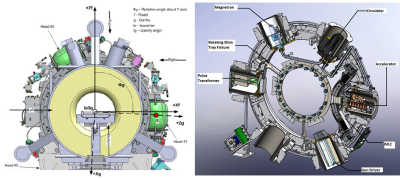 |
26 |
Comparison of MRI subsystem performances for two models of MRI-guided radiotherapy: MRI-Cobalt-60 versus MRI-Linac
Video Permission Withheld
Olga Green, James Flock, Rajiv Lotey, Austen Curcuru, Sasa Mutic, H Michael Gach
The era of MRI-guided radiation therapy (MR-IGRT) began in January 2014 when the first patient was treated with 60Co under real-time MRI guidance. In 2017, the first FDA-approved MRI-Linac began treating patients. Both systems incorporate a double donut magnet design with a 28 cm gap for the radiation beam. A rotating gantry carries either three shielded 60Co heads or a 6 MV Linac with magnetic and RF shielding. In this study, we compare the MRI subsystem performance between the two systems.
|
|
4416.
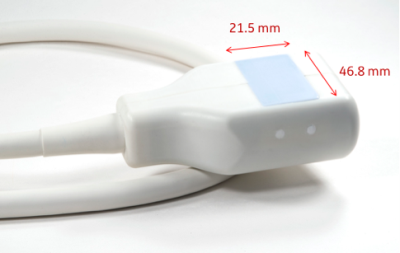 |
27 |
 Simultaneous MR and Ultrasound Acquisition for Image Guided Radiation Therapy using an MR-compatible, Hands-free, Electronically Steerable Ultrasound Transducer Simultaneous MR and Ultrasound Acquisition for Image Guided Radiation Therapy using an MR-compatible, Hands-free, Electronically Steerable Ultrasound Transducer
Thomas Foo, Warren Lee, David Mills, David Shoudy, Heather Chan, Aqsa Patel, James Sabatini, Timothy Fiorillo, Eric Fiveland, Lowell Smith, Bo Wang, Jhimli Mitra, Shourya Sarcar, Alan McMillan, James Holmes, Wes Culberson, Michael Bassetti, Charles Matrosic, Andrew Shepard, Bryan Bednarz
A new approach is developed for intrafractional motion management in radiation therapy (RT) that accounts for respiratory-induced motion using a prior simultaneous MR-ultrasound acquisition to provide “virtual” real-time MR image guidance during the RT procedure. This proposed solution first acquires simultaneous MR and ultrasound to link MR images to different respiratory states that are determined from 4D ultrasound images. During the RT procedure, the hands-free 4D ultrasound determines the respiratory state from displacement of endogenous fiducial markers. MR images corresponding to each respiratory state are displayed to provide an indication of the tumor target relative to the radiation beam.
|
|
4417.
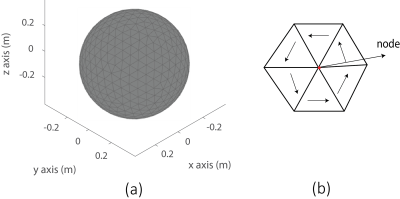 |
28 |
 A Novel Hybrid Method for Gradient Nonlinearity (GNL) Correction for MRI- Linac system A Novel Hybrid Method for Gradient Nonlinearity (GNL) Correction for MRI- Linac system
Shanshan shan, Mingyan Li, Yaohui Wang, Fangfang Tang, Deming Wang, Haiwei Chen, Ewald Weber, Rafael Franco, Craig Freakley , Feng Liu, Stuart Crozier
MRI-guided radiotherapy requires precise image geometric information to target a tumour without unnecessary radiation on healthy surrounding tissue. Due to the imperfections in the gradient system and engineering limitations, however, gradient non-linearity (GNL) inevitably occurs and causes image distortions if not properly accounted for. Here we propose a novel method to estimate the gradient field using stream function methods with a grid phantom. The estimated gradient field was then used for GNL distortion correction and image reconstruction. Initial simulations demonstrated that the image geometric distortion in a combined MRI and linear accelerator (MRI-Linac) system was effectively improved by the proposed method.
|
|
4418.
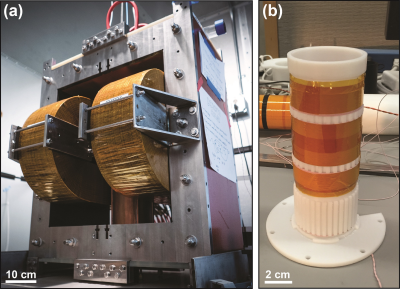 |
29 |
 High Resolution Tomographic Imaging with a 6.3 T/m Field Free Line Magnetic Particle Imager High Resolution Tomographic Imaging with a 6.3 T/m Field Free Line Magnetic Particle Imager
Elaine Yu, Bo Zheng, Zhi Wei Tay, Paul Keselman, Xinyi Zhou, Ryan Orendorff, Daniel Hensley, R Ferguson, Amit Khandhar, Scott Kemp, Kannan Krishnan, Patrick Goodwill, Steven Conolly
Magnetic Particle Imaging (MPI) is a novel, high-contrast, and quantitative imaging modality that directly detects superparamagnetic iron oxide nanoparticle (SPIO) tracers. In MPI, the imaging sensitive region is a field free region produced by a strong gradient selection field. There are two imaging formats in MPI: Field Free Point (FFP) and Field Free Line (FFL). The spatial resolution of our previous FFL imager was limited by the strength of the FFL gradient (2.35 T/m). Here we describe the hardware development of a high resolution 6.3 T/m FFL MPI system using water-cooled electromagnets and a laminated iron-core.
|
|
4419.
 |
30 |
 A 3T Head Scanner Designing Stage: the HTS magnet and the 200mT/m Hyper-Vision Gradient Coil. A 3T Head Scanner Designing Stage: the HTS magnet and the 200mT/m Hyper-Vision Gradient Coil.
Hector Sanchez Lopez, Hidenao FUKUYAMA
This work presents the design stage of a 3T MRI head scanner aimed to register temporal physiological events in the scale below 1 sec while imaging brain structures below 0.5 mm of resolution. The hyper-vision gradient coil concept is capable to produce 200 mT/m and nearly 1900 T/m/s using a high end amplifier. The 3D folded coil exhibits shoulder cut of an aperture of 250 mm and a DSV of 250mmx210mm while keeping resistance, eddy currents, force and inductive decoupling with the HTS magnet under control. Details and characteristics of the coil and magnet are presented in this work.
|
|
4420.
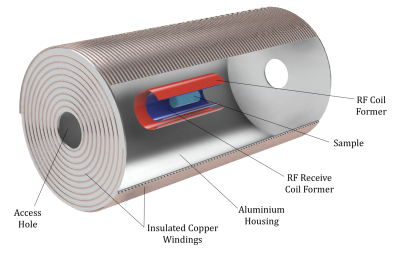 |
31 |
 Laplacian-Inspired Design of a Highly-Homogeneous, RF Shielded Magnet for Low-Field TRASE MRI Laplacian-Inspired Design of a Highly-Homogeneous, RF Shielded Magnet for Low-Field TRASE MRI
K.M. Smith, C.P. Bidinosti, Scott King
We present a novel Laplacian design method for a finite length magnet with perfect field homogeneity. It will be used to study TRansmit Array Spatial Encoding (TRASE) MRI at low field. As TRASE does not require the application of switched B0 gradients, we propose to build the magnet on an aluminum housing which acts both as a heat sink and effective low-frequency RF shield.
|
|
4421.
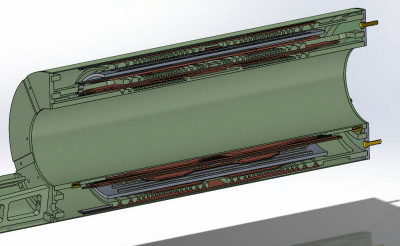 |
32 |
 Development of a Gradient and Shim Insert System for Marmoset Imaging at 9.4 T Development of a Gradient and Shim Insert System for Marmoset Imaging at 9.4 T
Justin Peterson, Ryan Chaddock, Brian Dalrymple, Frank Van Sas, Kyle Gilbert, Martyn Klassen, Joseph Gati, William Handler, Blaine Chronik
A replacement gradient coil for a 9.4 T preclinical system (31-cm inner diameter magnet) has been designed and is currently under construction. The new gradient and shim system will allow for improved imaging performance on the 9.4 T system, and has been developed specifically for marmoset imaging studies. Efficiencies of 1.5 mT/m/A for an ROI of size 8.5 cm at 5% homogeneity were achieved. A 10-channel shim set (not including first-order gradient shims) is included, with minimized inductive coupling to the gradient axes.
|
|
4422.
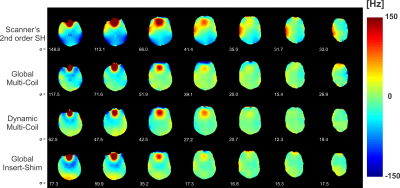 |
33 |
 A true comparison of B0 shimming with a very high order spherical harmonic based setup and a multi-coil shim array A true comparison of B0 shimming with a very high order spherical harmonic based setup and a multi-coil shim array
Ali Aghaeifar, Paul Chang, Sahar Nassirpour, Martin Eschelbach, Anke Henning, Klaus Scheffler
In this work, a true experimental comparison between a very high order spherical harmonic based shim setup and a multi-coil shim array is presented. Each technique has its own cons and pros which are studied through several often-used sequences. All evaluations are performed by shimming of the human brain at 9.4T.
|
|
4423.
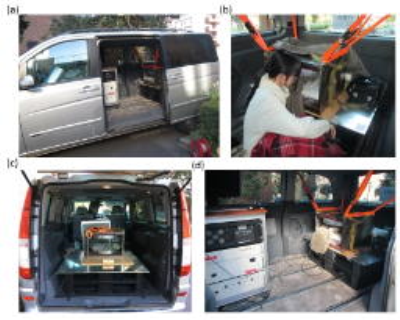 |
34 |
 Development of a small-car mountable MRI system for human extremities using a 0.2 T permanent magnet Development of a small-car mountable MRI system for human extremities using a 0.2 T permanent magnet
Katsumasa Tanabe, Mayu Nakagomi, Katsumi Kose, Yoshikazu Okamoto, Sodai Hoshiai, Yasuhiko Terada
We developed a new, compact portable MRI system for imaging extremities using a 0.2 T permanent magnet. The system was sufficiently small in size and mountable on a small, standard-sized vehicle. The use of the open-geometry magnet enabled the easy patient positioning within the limited space in the vehicle. We showed that our portable MRI provides clinically relevant images. The portable system might be deployable during sport events or in resource-poor environments access to MRI systems, and allow mass screening, early diagnosis, and case finding.
|
|
4424.
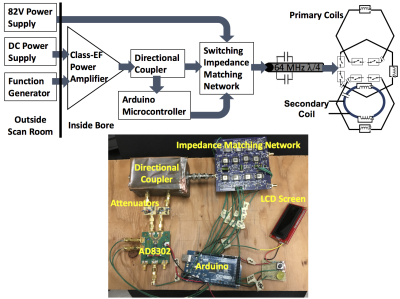 |
35 |
 Switching Impedance Matching and Primary Coil Array Using RF MEMS switches for a Wireless Power Transfer System Switching Impedance Matching and Primary Coil Array Using RF MEMS switches for a Wireless Power Transfer System
Kelly Byron, Fraser Robb, Shreyas Vasanawala, John Pauly, Greig Scott
Wireless power transfer (WPT) inside the MRI bore, as part of completely wireless patient coils, should have minimal RF interactions and be a compact system that allows for flexible placement of the coils while maintaining power transfer efficiency. Changes in coil positions can drastically reduce power amplifier efficiency. Here we present a MEMS based auto-tuning approach to compensate for the varying load seen by the power amplifier. An array primary coils also using high-power RF MEMS devices to steer power to a local secondary coil is also demonstrated.
|
|
4425.
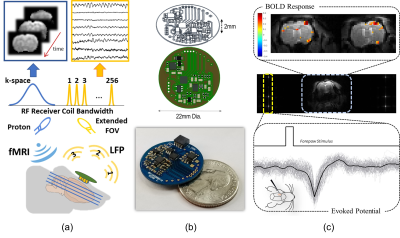 |
36 |
 Recording Electrophysiological Signals Through MR Receiver Coils During Concurrent fMRI Recording Electrophysiological Signals Through MR Receiver Coils During Concurrent fMRI
Ranajay Mandal, Nishant Babaria, Jiayue Cao, Zhongming Liu
Simultaneous recording of fMRI and electrophysiological (EP) signals, e.g. electroencephalography (EEG), electrocorticography (ECoG), and local field potentials (LFP) holds significant potential to evaluate the brain dynamics and its underlying neural circuitry across various spatiotemporal scales. However methodological challenges associated with bio-potential recording within MRI still work as a bottleneck. Here we present a miniaturized, MR-compatible device that can adaptively learn the presence of electromagnetic artifacts and can perform high fidelity EP recording (ECG, LFP, SEP etc.) wirelessly through the MR-receiver coil. The low power device provides a cheap and simple solution for recording various electrophysiological signals during concurrent fMRI.
|
|
4426.
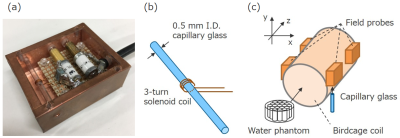 |
37 |
 Development of a field camera system for a customized 1.5 T compact MRI system Development of a field camera system for a customized 1.5 T compact MRI system
Yuta Kobayashi, Katsumi Kose, Yasuhiko Terada
We developed a field camera system for a 1.5T/280mm superconducting magnet system with unshielded gradient coils. K-space trajectories of a two-dimensional spiral scan were monitored using the field camera system and predicted based on a gradient impulse response function (GIRF). Image reconstruction with these trajectories was effective to recover artifact-free images, even in the presence of hardware imperfections. This result showed the validity of the system.
|
|
4427.
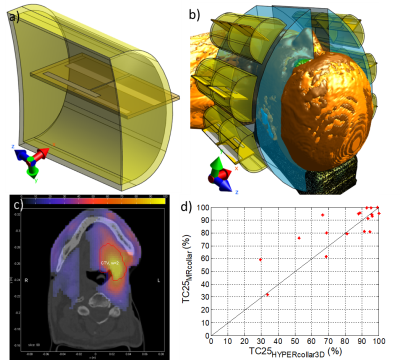 |
38 |
 Novel applicator design for MR guided RF hyperthermia in head and neck cancers: heating performance and RF coupling Novel applicator design for MR guided RF hyperthermia in head and neck cancers: heating performance and RF coupling
Margarethus Paulides, Tomas Drizdal, Gerard Van Rhoon, Desmond Yeo
Clinical studies have established the clinical benefit of adjuvant mild hyperthermia in the head and neck, but further improvements are hampered by an inadequate temperature dosimetry. We designed a novel MR compatible hyperthermia applicator ("MRcollar") based on a previously developed antenna concept. Despite the tradeoffs faced when combining heating and imaging, good power focusing ability, i.e. hyperthermia quality, and MRI compatibility were demonstrated by simulations and a reduced scale experiment.
|
|
4428.
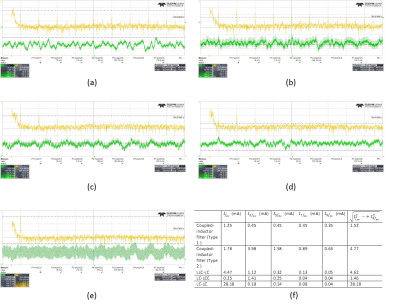 |
39 |
 Output Filter Design for Gradient Amplifier and Shimming Amplifier of MRI: an Overview Output Filter Design for Gradient Amplifier and Shimming Amplifier of MRI: an Overview
Huijun Yu, Sebastian Littin, Feng Jia, Stefan Kroboth, Maxim Zaitsev
Switch-mode gradient amplifiers are widely employed in magnetic resonance imaging systems to drive gradient coils with high current and voltage to provide fast slew rates. The pulse-width modulation control results in unavoidable current ripple and switching noise. Therefore an effective filter is required to attenuate the current ripple and switching noise to avoid image artifacts. Common methods include using single or two stages of LC low pass filter with a disadvantage of bulky size and low ripple attenuation at the switching frequency. Here we present four different filters as alternative designs that introduce a notch mode.
|
|
4429.
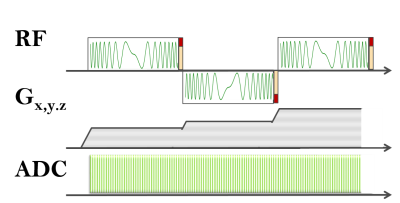 |
40 |
 Concurrent Excitation and Acquisition for the Ultimate MRI Experience: Silent, Implant Friendly, Nearly 100% Efficient Concurrent Excitation and Acquisition for the Ultimate MRI Experience: Silent, Implant Friendly, Nearly 100% Efficient
Ali Özen, Burak Akin, Michael Bock
Concurrent excitation and acquisition (CEA) allows detecting the MR signal during frequency-swept radio-frequency (RF) excitation without dead times. In our previous work, CEA was realized in a clinical MRI system using a fully automated analog cancellation unit to suppress the unwanted transmit signal leakage during signal reception. In this study, CEA MRI of human head was compared to a 3D UTE sequence; a very fast CEA protocol was demonstrated for 3D radial acquisition of a human ankle; finally rapid passage excitation of the CEA was compared to a hard pulse in terms of SAR.
|
|
4430.
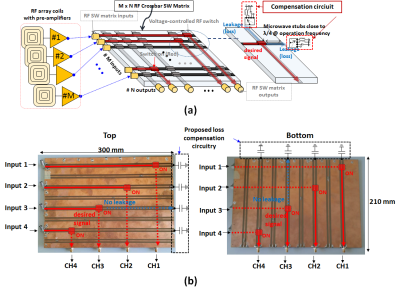 |
41 |
 A Signal Loss Compensation Method in an RF switch matrix system in Ultra High Field MRI A Signal Loss Compensation Method in an RF switch matrix system in Ultra High Field MRI
YunKyoung Ko, Chang-Hoon Choi, N.Jon Shah
A crossbar switch matrix can be flexibly connected to any input and output paths via RF switches. However, this type of matrix creates open-stubs in the RF lines. Since the RF wavelength becomes shorter as the magnetic field increases, signal loss due to impedance variations in RF pathways becomes severe, thus degrading image quality. In this study, we propose an advanced compensation method and verify its performance in ultra-high field MRI with single and multi-channel array coils.
|
|
4431.
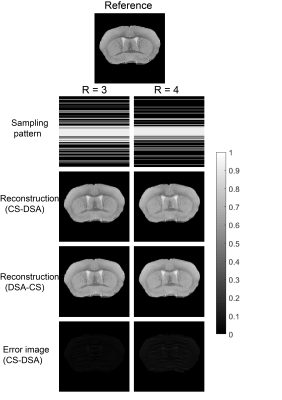 |
42 |
 Advancement in Dynamic Sensitivity Averaging for a Rotating RF Coil (RRFC) at 9.4T with Compressed Sensing Advancement in Dynamic Sensitivity Averaging for a Rotating RF Coil (RRFC) at 9.4T with Compressed Sensing
Mingyan Li, Feng Liu, Jin Jin, Ewald Weber, Stuart Crozier
We have previously developed a practical imaging scheme for the rotating RF coil (RRFC) in Cartesian trajectories. This scheme employs dynamic sensitivity averaging (DSA) of multiple k-spaces during coil rotation, which eliminates the need of time-consuming, position-dependent sensitivity estimation for image reconstruction of the RRFC. As demonstrated in previous work, two extra complementary profiles are required to achieve efficient DSA, thus the scan duration is potentially extended. To further improve the efficiency of DSA, compressed sensing (CS) is implemented to the image reconstruction of the RRFC.
|
|
4432.
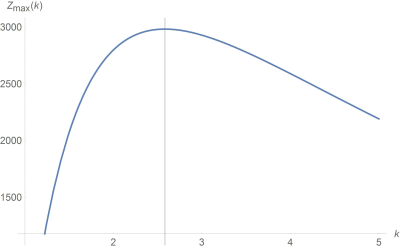 |
43 |
 Optimal Bazooka Balun Proportions Optimal Bazooka Balun Proportions
Victor Taracila, Luke Smith, Ceara Stack, Fraser Robb
In MRI, traditional RF coils have cables, which supply the on-coil electronics with power and carry the received signals out from the receive elements to further amplification, digitization and post-processing. The standard technique for blocking currents being induced on the cables uses RF traps, colloquially called bazooka baluns, which represent parallel resonant tanks coupled (magnetically) to the cable. Question: If the volume of the bazooka balun is fixed, what would be its diameter and length so that the impedance of the balun is maximized?
|
|
4433.
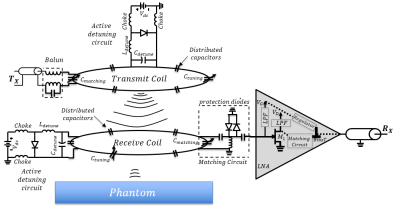 |
44 |
 Optimizing the combination of preamplifier input impedance and coil impedance for high-density receive arrays Optimizing the combination of preamplifier input impedance and coil impedance for high-density receive arrays
Ali Attaran, Kyle Gilbert, Blaine Chronik, Ravi Menon
Low-profile preamplifiers were developed to be used in multichannel coil arrays. Optimizing the combination of preamplifier input impedance and coil impedance for high-density receive arrays indicates that the highest SNR is obtained when using high input-impedance preamplifiers connected directly to high-impedance coils.
|
|
4434.
 |
45 |
 Design of a passive feed network to increase the transmit efficiency of dipoles at 7 Tesla Design of a passive feed network to increase the transmit efficiency of dipoles at 7 Tesla
Irena Zivkovic, Thomas O'Reilly, Wyger Brink, Andrew Webb
In this abstract, we presented a new way of feeding a dipole type antenna which increases the transmit efficiency (B1+ per square root maximum SAR). The main radiating antenna element was printed on one side of a dielectric substrate with capacitive coupling to a shorter straight dipole element used as the feed element printed on the opposite side. Indirectly (passively) and directly fed (conventional) meander antennas were fabricated and their performances were compared numerically and experimentally. The indirectly fed dipole antenna exhibited increase in transmit efficiency for straight and meandered dipoles.
|
|
4435.
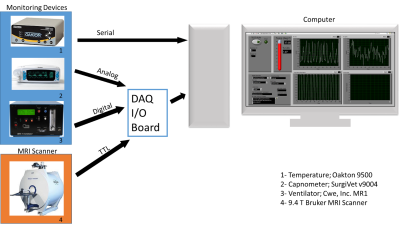 |
46 |
 Automated data acquisition system for fMRI resting state de-noising Automated data acquisition system for fMRI resting state de-noising
Grace Li Haug, Domenic Cerri, Yen-Yu Shih, SungHo Lee
We have developed an automated system for collecting data from monitoring devices for animal functional MRI (fMRI) research to clean the effects of the physiological nuisance signal. Graphical user interface (GUI) is also provided to make a convenient environment for monitoring animal vital signs on one screen. To demonstrate the system’s usefulness, we perform CBV-based resting-state fMRI and compare the changes of temporal signal-to-noise ratio (tSNR) in the striatum between the before and after end-tidal CO2 (EtCO2) signal correction using RETROICOR algorithm. The software automates the time synchronization among the collected data and will be expanded to automate the noise filtering process.
|
|
4436.
 |
47 |
 FPGA processors of Parallelized 2D FFT suitable for real-time RARE image reconstruction FPGA processors of Parallelized 2D FFT suitable for real-time RARE image reconstruction
Limin Li, Alice Wyrwicz
We report here a new parallelized 2D FFT algorithm suitable for real-time RARE image reconstruction and describe how to implement the algorithm on a Field-Programmable Gate Array (FPGA). We will present the design and testing of these FPGA processors, and demonstrate their utility in reconstructing RARE images.
|
|
4437.
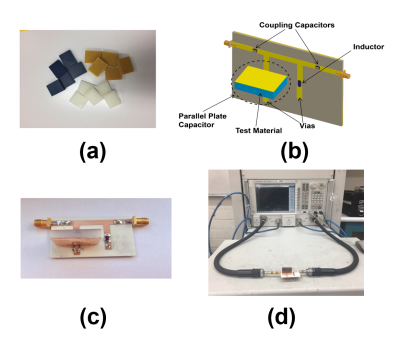 |
48 |
 On the Properties of Additive Manufacturing Materials for Anatomy Specific 3D-Printed MRI Coils On the Properties of Additive Manufacturing Materials for Anatomy Specific 3D-Printed MRI Coils
Bahareh Behzadnezhad, Bruce Collick, Nader Behdad, Alan McMillan
Additive manufacturing provides a low-cost and rapid means to translate 3D design into the construction of a prototype. For MRI, this type of manufacturing can be used to construct various components including the structure of RF coils. In this abstract, we characterize the material properties (dielectric constant and loss tangent) of several common 3D-printed plastics, and utilize these material properties in full-wave electromagnetic simulations to design and construct a very low-cost subject/anatomy-specific 3D-printed receive-only RF coil that fits close to the body. We show that the anatomy-specific coil exhibits higher signal-to-noise ratio compared to a conventional flat surface coil.
|
|
| Back |
| The International Society for Magnetic Resonance in Medicine is accredited by the Accreditation Council for Continuing Medical Education to provide continuing medical education for physicians. |

































































































